
Imperial Elegance: Prague, Vienna and Budapest Itinerary 14 Days
 14 Day Tour of Prague, Vienna and Budapest
14 Day Tour of Prague, Vienna and Budapest
Overview
Trip Map
Itinerary
Inclusions
Reviews







14 Days 13 Nights
Best Time: Jan-Dec
Cultural Exploration
History Buffs
Embark on a captivating 2-week trip in Prague, Vienna & Budapest. Uncover Prague's charm through cobbled streets, discovering iconic landmarks like Charles Bridge, Prague Castle, Petrin Hill & the historic Jewish Quarter. In Vienna, delve into Imperial Palaces and world-class art galleries such as the Belvedere Palace where masterpieces such as Gustav Klimt's "The Kiss" are showcased. Budapest offers relaxation in thermal baths, a glimpse of the 13th-century Buda Castle, and panoramic views from Gellert Hill. This curated travel itinerary promises a rich experience, seamlessly merging historic sites, natural beauty, and cultural immersion.
- Stroll across the iconic Charles Bridge, adorned with baroque statues
- Marvel at the opulence of Vienna's Imperial Palaces, including Schönbrunn Palace
- Relax in a thermal bath in Budapest before absorbing breathtaking views from Gellert Hill
- Explore the Wachau Valley, scenic vineyards, villages, and Melk Abbey.
- Visit the medieval masterpiece Karlstejn Castle nestled in the Czech countryside.
- Immerse yourself in the artistic charm of Szentendre, a picturesque town on the Danube Bend.
Embark on a captivating 2-week trip in Prague, Vienna & Budapest. Uncover Prague's charm through cobbled streets, discovering iconic landmarks like Charles Bridge, Prague Castle, Petrin Hill & the historic Jewish Quarter. In Vienna, delve into Imperial Palaces and world-class art galleries such as the Belvedere Palace where masterpieces such as Gustav Klimt's "The Kiss" are showcased. Budapest offers relaxation in thermal baths, a glimpse of the 13th-century Buda Castle, and panoramic views from Gellert Hill. This curated travel itinerary promises a rich experience, seamlessly merging historic sites, natural beauty, and cultural immersion.
- Stroll across the iconic Charles Bridge, adorned with baroque statues
- Marvel at the opulence of Vienna's Imperial Palaces, including Schönbrunn Palace
- Relax in a thermal bath in Budapest before absorbing breathtaking views from Gellert Hill
- Explore the Wachau Valley, scenic vineyards, villages, and Melk Abbey.
- Visit the medieval masterpiece Karlstejn Castle nestled in the Czech countryside.
- Immerse yourself in the artistic charm of Szentendre, a picturesque town on the Danube Bend.

Prague Castle
Castles & Chateaux

Charles Bridge
Historic Landmarks

Hofburg Palace
Castles & Chateaux

Schönbrunn Palace & Zoo
Parks & Gardens

Gellert Hill & Baths
Parks & Gardens

Castle Hill
Castles & Chateaux
Must see sights

Prague Castle
Castles & Chateaux

Charles Bridge
Historic Landmarks

Hofburg Palace
Castles & Chateaux

Schönbrunn Palace & Zoo
Parks & Gardens

Gellert Hill & Baths
Parks & Gardens

Castle Hill
Castles & Chateaux
Starting from
$2350
per person
 Not included
Not included Secure Your Customizable Trip
Enter your details to embark on a journey that can be tailored just for you.
Start
Travelers
Add Room
Remove Room
Preferred Hotel Stars
Craft Your Own Itinerary
Select your interests and destinations for a trip plan inspired by you.
Trip Map & Itinerary
Enable/Disable Map Scrolling
Click To Make Map Interactive

Trip Timeline
 Edit Details
Edit DetailsArrival
4 nights
Prague
Czech Republic
Train: 4.5h
4 nights
Vienna
Austria
Train: 3h
5 nights
Budapest
Hungary
Departure
Day-By-Day Itinerary
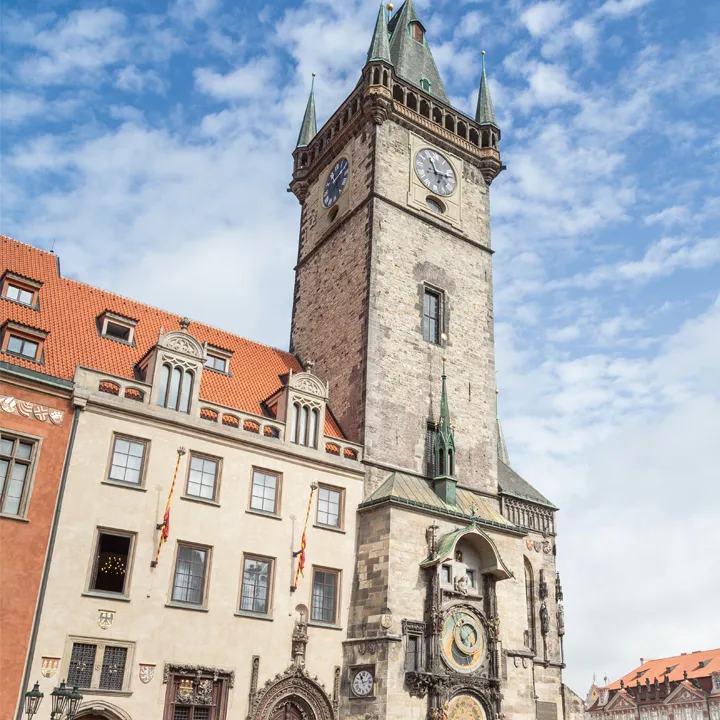
Day 1
Arrive Prague
View More
Day 1
Arrive Prague


To Be Determined
Arrival in Prague Airport & Transfer by Taxi
Prague has one main airport, Václav Havel Airport Prague, where almost all visitors arrive. Taxis are available directly at the terminal exit, or you can arrange a private transfer for added convenience.

Day 1
Arrive Prague
View More


Day 1
Arrive Prague



To Be Determined:
Airport Transfer
Mid-Day/Afternoon:
Old Town


Day 2
Prague
View More
Day 2
Prague



9:00 AM - 12:30 PM
Prague Castle & Royal Route Guided Walk
On this charming guided walk, you will explore the Prague Castle, the largest castle complex in all of Europe. To reach the castle you will trace the Royal Coronation Route and cross the Charles Bridge, whose “speaking stones” reveal the amazing and often cruel history that occurred there. Your tour guide will then take you either through the castle courtyards and into the dramatic St. Vitus Cathedral in the center of the castle complex, or through the upper part of the castle district around the oversized palaces of the old Catholic nobility and the top of the Castle Steps for incomparable views over the red rooftops of the Little Quarter.

Charles Bridge
Cross the river dividing Prague's most historic neighborhoods, and experience one of Europe's most iconic landmarks.
Show More

Maltese Square & Lennon Wall
See a historic wall that has been covered in John Lennon-inspired graffiti since Communist days.
Show More

Prague Castle
Prague Castle is one of the main attractions in Prague and is also the largest castle complex in the world.
Show More

Charles Bridge
Cross the river dividing Prague's most historic neighborhoods, and experience one of Europe's most iconic landmarks.
Show More

Maltese Square & Lennon Wall
See a historic wall that has been covered in John Lennon-inspired graffiti since Communist days.
Show More

Prague Castle
Prague Castle is one of the main attractions in Prague and is also the largest castle complex in the world.
Show More

Charles Bridge
Cross the river dividing Prague's most historic neighborhoods, and experience one of Europe's most iconic landmarks.
Show More
prev
next

Day 2
Prague
View More

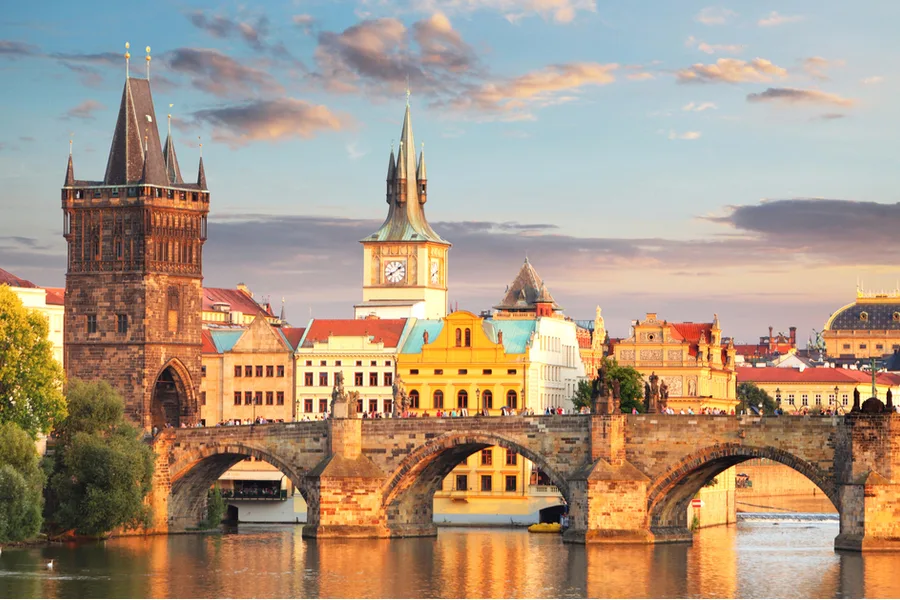
Charles Bridge
 Highlight of Royal Route Guided Tour
Highlight of Royal Route Guided TourCross the river dividing Prague's most historic neighborhoods, and experience one of Europe's most iconic landmarks.
Bridge construction began in 1357 under King Charles IV (hence the name), and it was the only bridge across the Vltava River until 1841. 30 baroque statues of saints line the bridge, and it is filled with street artists and entertainers. Not to be missed.

Maltese Square & Lennon Wall
 Highlight of Royal Route Guided Tour
Highlight of Royal Route Guided TourSee a historic wall that has been covered in John Lennon-inspired graffiti since Communist days.
The wall has been covered in graffiti since the 1960s, and during Communism anti-regime sentiment was common. John Lennon's assassination inspired grafitti reflecting his song, Imagine, which earned the wall its current moniker. It is now a favorite gathering place for tourists, and musicians sometimes congregate there as well. Just around the corner is the Maltese Square, which is one of Prague's more quaint and relaxed public spaces, despite being just off the main tourist route.

Prague Castle
 Highlight of Royal Route Guided Tour
Highlight of Royal Route Guided TourPrague Castle is one of the main attractions in Prague and is also the largest castle complex in the world.
The Prague Castle is the largest castle complex in the world with structures dating back to the 9th century. The St Vitus Cathedral and Basilica of St George can be found within the castle walls. The Prague Castle also includes several gardens, palaces, and a monastery. This castle was the seat of power for the Kings of Bohemia, Holy Roman Emperors, and presidents of former Czechoslovakia. Prague Castle is a UNESCO world heritage site and is one of the most visited places in the country.

Charles Bridge
 Highlight of Royal Route Guided Tour
Highlight of Royal Route Guided TourCross the river dividing Prague's most historic neighborhoods, and experience one of Europe's most iconic landmarks.
Bridge construction began in 1357 under King Charles IV (hence the name), and it was the only bridge across the Vltava River until 1841. 30 baroque statues of saints line the bridge, and it is filled with street artists and entertainers. Not to be missed.

Maltese Square & Lennon Wall
 Highlight of Royal Route Guided Tour
Highlight of Royal Route Guided TourSee a historic wall that has been covered in John Lennon-inspired graffiti since Communist days.
The wall has been covered in graffiti since the 1960s, and during Communism anti-regime sentiment was common. John Lennon's assassination inspired grafitti reflecting his song, Imagine, which earned the wall its current moniker. It is now a favorite gathering place for tourists, and musicians sometimes congregate there as well. Just around the corner is the Maltese Square, which is one of Prague's more quaint and relaxed public spaces, despite being just off the main tourist route.

Prague Castle
 Highlight of Royal Route Guided Tour
Highlight of Royal Route Guided TourPrague Castle is one of the main attractions in Prague and is also the largest castle complex in the world.
The Prague Castle is the largest castle complex in the world with structures dating back to the 9th century. The St Vitus Cathedral and Basilica of St George can be found within the castle walls. The Prague Castle also includes several gardens, palaces, and a monastery. This castle was the seat of power for the Kings of Bohemia, Holy Roman Emperors, and presidents of former Czechoslovakia. Prague Castle is a UNESCO world heritage site and is one of the most visited places in the country.

Charles Bridge
 Highlight of Royal Route Guided Tour
Highlight of Royal Route Guided TourCross the river dividing Prague's most historic neighborhoods, and experience one of Europe's most iconic landmarks.
Bridge construction began in 1357 under King Charles IV (hence the name), and it was the only bridge across the Vltava River until 1841. 30 baroque statues of saints line the bridge, and it is filled with street artists and entertainers. Not to be missed.
prev
next

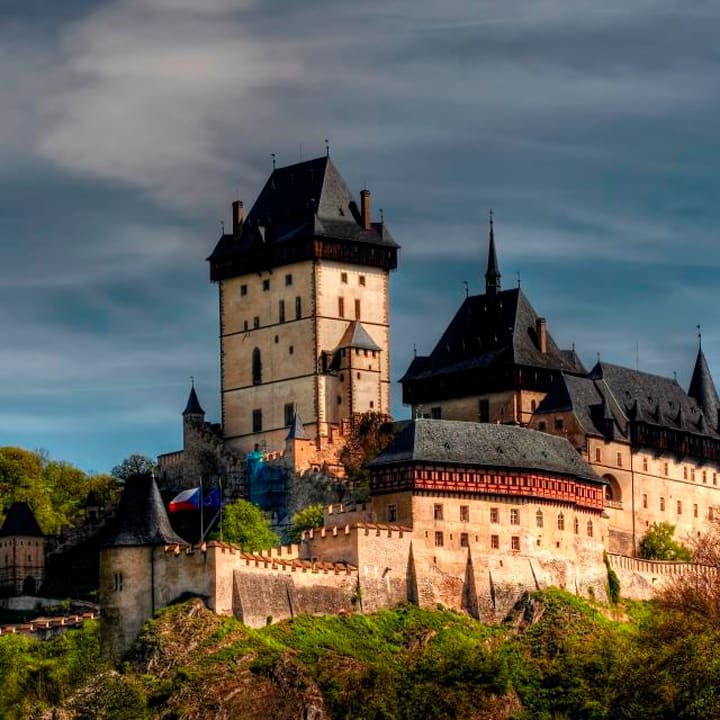
Day 3
Prague
View More
Day 3
Prague



Morning/Mid-Day
Excursion by Train to Karlštejn Castle
Karlštejn, i.e. Charles' Stone Castle, is the most famous castle in the Czech Republic. The fairy-tale perfect castle was founded by King Charles IV in 1348 to guard his royal treasures. It's massive towers and walls are spread out over a series of rocky peaks above the Berounka River and commands striking views of the surrounding hills.

Chapel of the Holy Rood
Tour a closely-guarded and jewel-encrusted chapel decorated with amazing medieval art.
Show More

Chapel of the Holy Rood
Tour a closely-guarded and jewel-encrusted chapel decorated with amazing medieval art.
Show More

Chapel of the Holy Rood
Tour a closely-guarded and jewel-encrusted chapel decorated with amazing medieval art.
Show More

Chapel of the Holy Rood
Tour a closely-guarded and jewel-encrusted chapel decorated with amazing medieval art.
Show More

Chapel of the Holy Rood
Tour a closely-guarded and jewel-encrusted chapel decorated with amazing medieval art.
Show More
prev
next

Day 3
Prague
View More

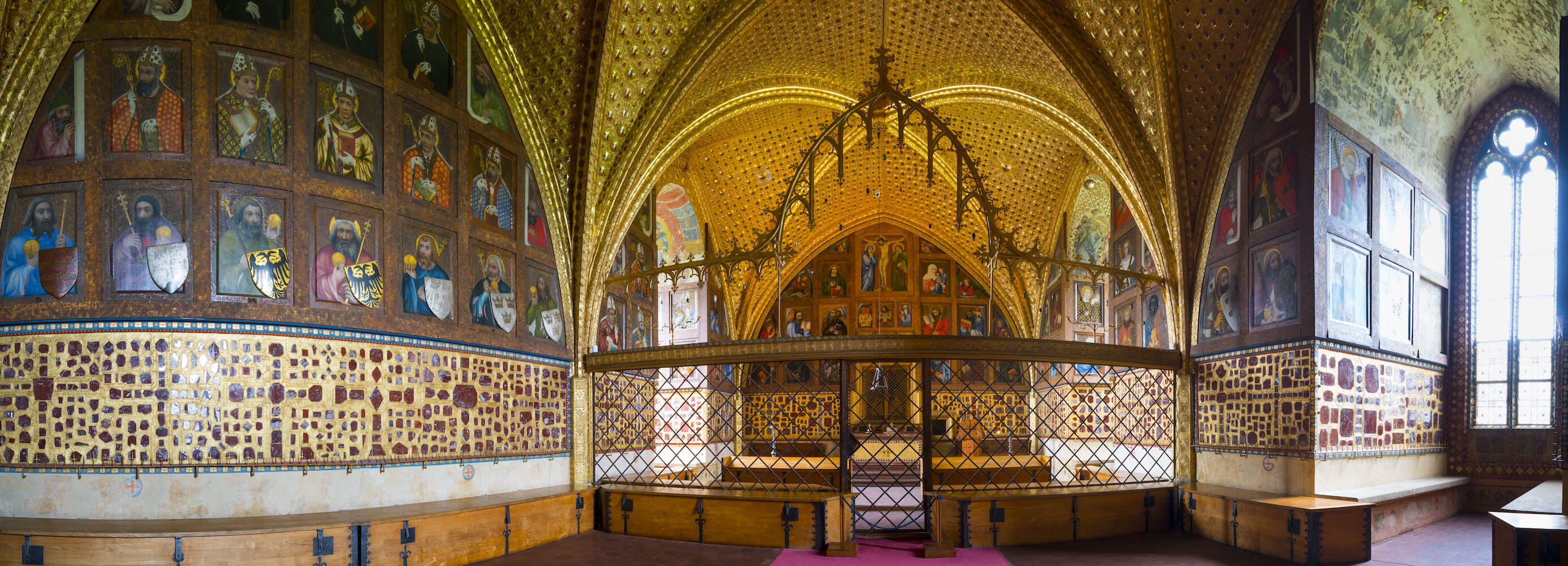
Chapel of the Holy Rood
 Highlight of Karlštejn Castle
Highlight of Karlštejn CastleTour a closely-guarded and jewel-encrusted chapel decorated with amazing medieval art.
The most important and impressive part of the castle, the Chapel of the Holy Rood, is open only to special guided tours due to the fact that its walls are literally covered in precious jewels.

Chapel of the Holy Rood
 Highlight of Karlštejn Castle
Highlight of Karlštejn CastleTour a closely-guarded and jewel-encrusted chapel decorated with amazing medieval art.
The most important and impressive part of the castle, the Chapel of the Holy Rood, is open only to special guided tours due to the fact that its walls are literally covered in precious jewels.

Chapel of the Holy Rood
 Highlight of Karlštejn Castle
Highlight of Karlštejn CastleTour a closely-guarded and jewel-encrusted chapel decorated with amazing medieval art.
The most important and impressive part of the castle, the Chapel of the Holy Rood, is open only to special guided tours due to the fact that its walls are literally covered in precious jewels.

Chapel of the Holy Rood
 Highlight of Karlštejn Castle
Highlight of Karlštejn CastleTour a closely-guarded and jewel-encrusted chapel decorated with amazing medieval art.
The most important and impressive part of the castle, the Chapel of the Holy Rood, is open only to special guided tours due to the fact that its walls are literally covered in precious jewels.

Chapel of the Holy Rood
 Highlight of Karlštejn Castle
Highlight of Karlštejn CastleTour a closely-guarded and jewel-encrusted chapel decorated with amazing medieval art.
The most important and impressive part of the castle, the Chapel of the Holy Rood, is open only to special guided tours due to the fact that its walls are literally covered in precious jewels.
prev
next

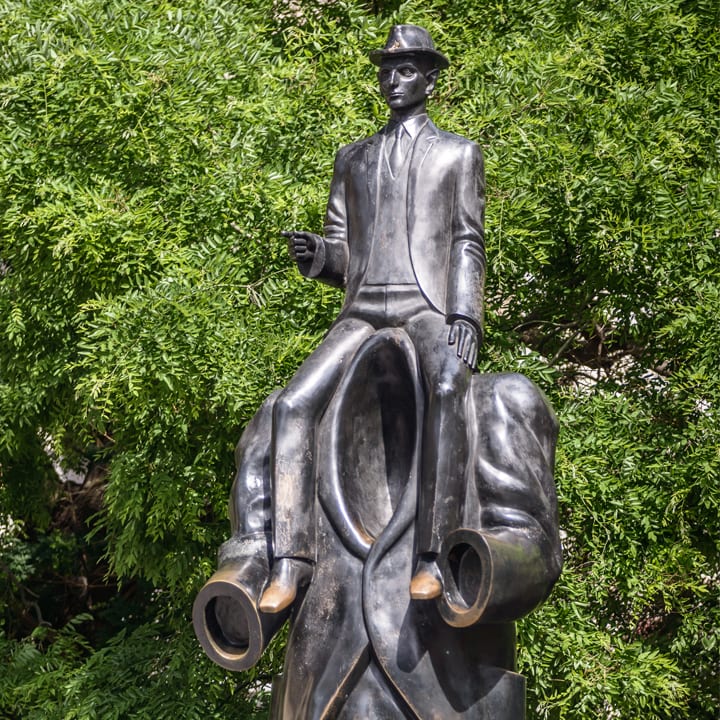
Day 4
Prague
View More
Day 4
Prague




Morning
Visit Prague's Jewish Quarter
Jews have lived in Prague since its beginnings in the 10th century and have endowed it with a rich heritage. The ghetto was created in the 12th century, as Jews were forced to live separately from Christians. Despite persecution, the community prospered, but sadly, only a small minority survived the Nazi occupation. A lasting legacy remains, including synagogues, architecture, and a fascinating cemetery.

Spanish Synagogue
Discover the synagogue considered by many to be Prague's most beautiful.
Show More

Old-New Synagogue
See the oldest surviving synagogue in Europe and also one of Prague's earliest Gothic buildings.
Show More

Old Jewish Cemetery
Take an unforgettable visit to one of Europe's largest medieval Jewish cemeteries.
Show More

Spanish Synagogue
Discover the synagogue considered by many to be Prague's most beautiful.
Show More

Old-New Synagogue
See the oldest surviving synagogue in Europe and also one of Prague's earliest Gothic buildings.
Show More

Old Jewish Cemetery
Take an unforgettable visit to one of Europe's largest medieval Jewish cemeteries.
Show More

Spanish Synagogue
Discover the synagogue considered by many to be Prague's most beautiful.
Show More
prev
next

Day 4
Prague
View More


Spanish Synagogue
 Highlight of Jewish Quarter
Highlight of Jewish QuarterDiscover the synagogue considered by many to be Prague's most beautiful.
Completed in 1868, the Spanish Synagogue is the newest synagogue in Prague's Jewish Quarter, but happens to be built on the site of the former Oldest Synagogue in Prague. It is built in a stunning Spanish Moorish style as a symbol of the flowering of the Jewish culture which occurred under Muslim rule on the Iberian Peninsula.

Old-New Synagogue
 Highlight of Jewish Quarter
Highlight of Jewish QuarterSee the oldest surviving synagogue in Europe and also one of Prague's earliest Gothic buildings.
When built it was Prague’s newest synagogue, but over time became its oldest – hence the “Old-New”. A beautiful ark holds the Torah and legend says its attic is the hiding place of the legendary clay Golem.

Old Jewish Cemetery
 Highlight of Jewish Quarter
Highlight of Jewish QuarterTake an unforgettable visit to one of Europe's largest medieval Jewish cemeteries.
As the Jewish Ghetto was quite cramped, there was no room to expand the cemetery. Unable to acquire further land, and not wishing to dishonor ancestors through the demolition of existing graves, Prague's Jews buried their loved ones in multiple levels. Gravestones are packed in tightly and in some areas the burials reach 12 layers!

Spanish Synagogue
 Highlight of Jewish Quarter
Highlight of Jewish QuarterDiscover the synagogue considered by many to be Prague's most beautiful.
Completed in 1868, the Spanish Synagogue is the newest synagogue in Prague's Jewish Quarter, but happens to be built on the site of the former Oldest Synagogue in Prague. It is built in a stunning Spanish Moorish style as a symbol of the flowering of the Jewish culture which occurred under Muslim rule on the Iberian Peninsula.

Old-New Synagogue
 Highlight of Jewish Quarter
Highlight of Jewish QuarterSee the oldest surviving synagogue in Europe and also one of Prague's earliest Gothic buildings.
When built it was Prague’s newest synagogue, but over time became its oldest – hence the “Old-New”. A beautiful ark holds the Torah and legend says its attic is the hiding place of the legendary clay Golem.

Old Jewish Cemetery
 Highlight of Jewish Quarter
Highlight of Jewish QuarterTake an unforgettable visit to one of Europe's largest medieval Jewish cemeteries.
As the Jewish Ghetto was quite cramped, there was no room to expand the cemetery. Unable to acquire further land, and not wishing to dishonor ancestors through the demolition of existing graves, Prague's Jews buried their loved ones in multiple levels. Gravestones are packed in tightly and in some areas the burials reach 12 layers!

Spanish Synagogue
 Highlight of Jewish Quarter
Highlight of Jewish QuarterDiscover the synagogue considered by many to be Prague's most beautiful.
Completed in 1868, the Spanish Synagogue is the newest synagogue in Prague's Jewish Quarter, but happens to be built on the site of the former Oldest Synagogue in Prague. It is built in a stunning Spanish Moorish style as a symbol of the flowering of the Jewish culture which occurred under Muslim rule on the Iberian Peninsula.
prev
next

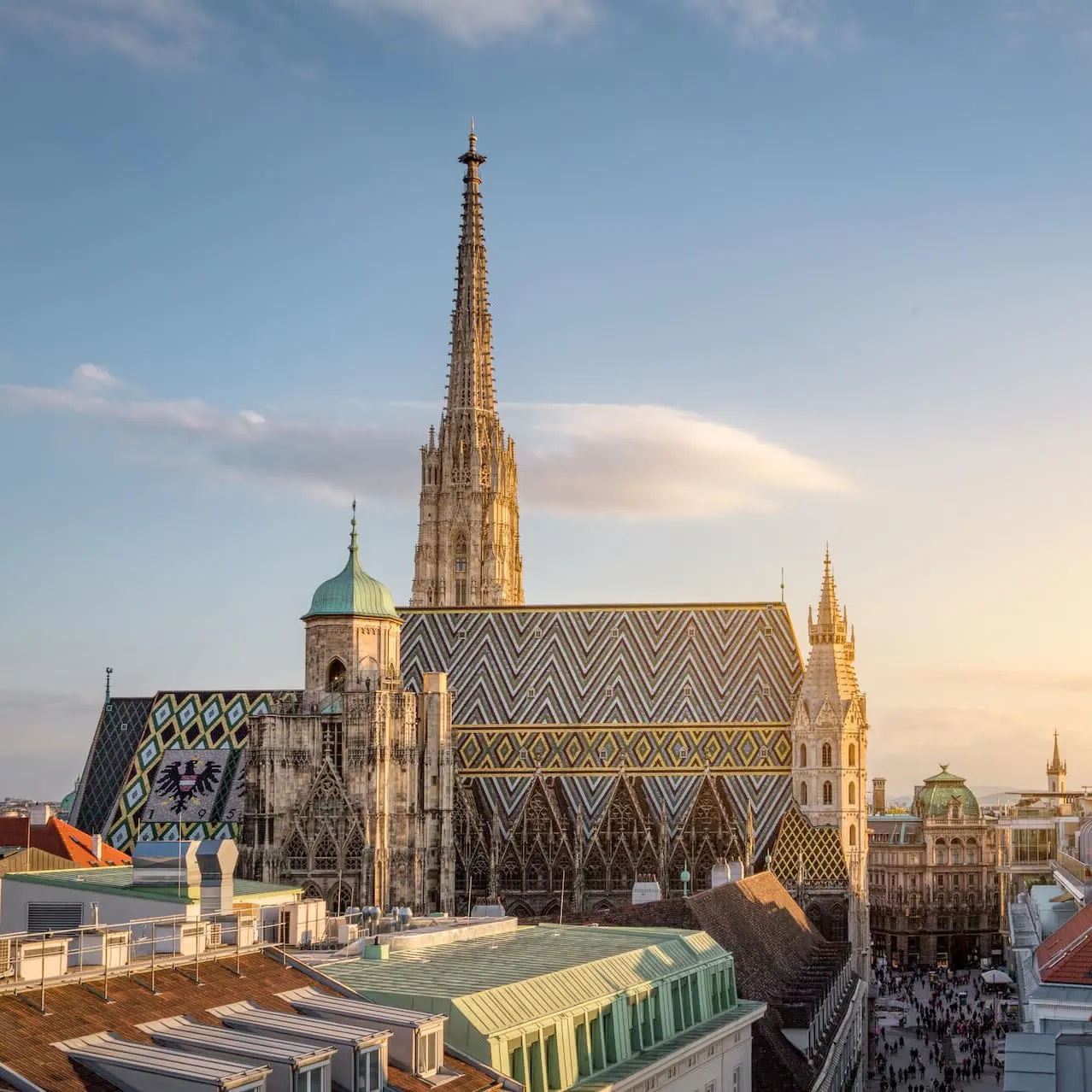
Day 5
Prague to Vienna
View More
Day 5
Prague to Vienna





9:35 AM
Transfer to Station by Taxi or Public Transport
Most trains depart from Prague Main Station (Praha hl.n.) station, the largest station in the city. Before spending money on a transfer, be sure to check whether your hotel is within easy walking distance. Also consider that the cheapest and sometimes fastest way to reach your hotel may be by public transport. If staying at a hotel, they can order a reliable taxi. Some private transfers will even help with your bags. Uber is also available for those with the app. Information on finding your departure platform is provided in the itinerary mobile app.

Day 5
Prague to Vienna
View More



Day 6
Vienna
View More
Day 6
Vienna



9:30 AM - 12:00 PM
Guided Walk through Vienna's Inner City
This tour takes you back in history to explore the Vienna that stood within the old city walls. You will learn about the humble beginnings of Vienna before it became the capital of a great empire and one of the most important cities in Europe. You will discover how Vienna's early inhabitants lived and how they left their mark on the city and its beautiful Medieval, Renaissance, and Baroque architecture.

Day 6
Vienna
View More


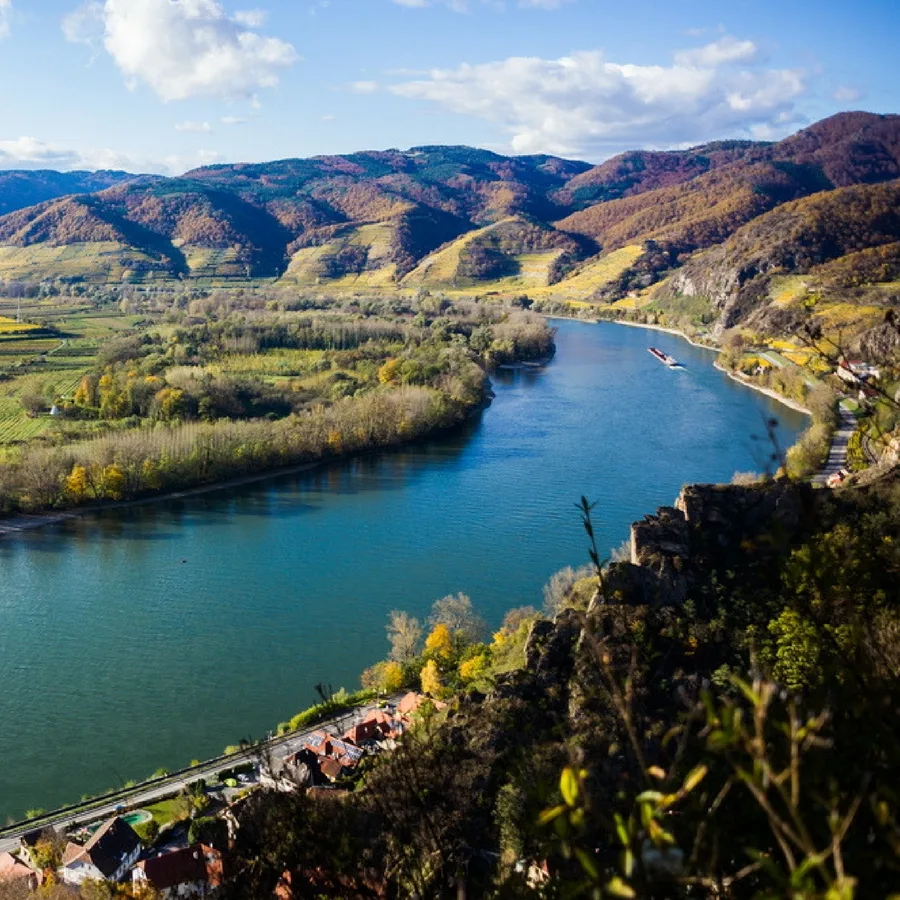
Day 7
Vienna
View More
Day 7
Vienna

Early Morning to Late Afternoon
Danube Cruise in the Scenic Wachau Valley
A one-and-a-half-hour train ride from Vienna brings you to the town of Melk, where you can tour the vast Melk Abbey. From there you can begin a 22-mile cruise through the Wachau Valley, considered the most beautiful stretch of the entire Danube River. You'll pass medieval castle ruins, hills covered in vineyards, and several charming villages, where you can debark to try some wine or take a hike up to a castle. The valley is also a perfect destination for cyclers and winery tours.

Dürnstein
Explore the twisting narrow lanes of this delightful monastery town.
Show More

Dürnstein Castle Ruins
Hike to the dramatic ruins of a medieval castle built in 1100's.
Show More

Melk Abbey
Tour a huge and splendid Baroque monastery.
Show More

Spitz
Stop to taste the wine in a postcard-pretty town surrounded by vineyards.
Show More

Dürnstein
Explore the twisting narrow lanes of this delightful monastery town.
Show More

Dürnstein Castle Ruins
Hike to the dramatic ruins of a medieval castle built in 1100's.
Show More

Melk Abbey
Tour a huge and splendid Baroque monastery.
Show More

Spitz
Stop to taste the wine in a postcard-pretty town surrounded by vineyards.
Show More
prev
next

Day 7
Vienna
View More

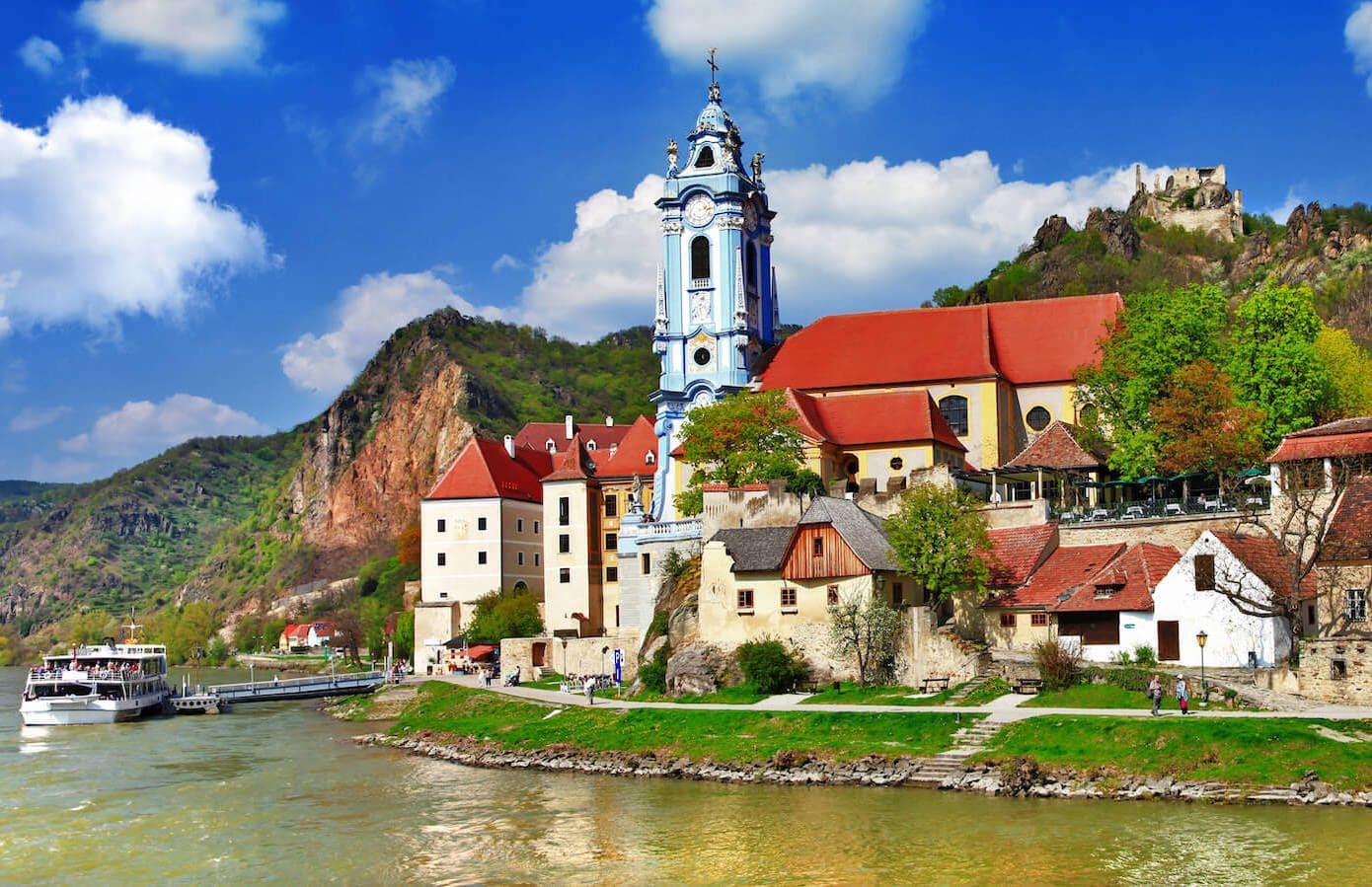
Dürnstein
 Highlight of Wachau Valley
Highlight of Wachau ValleyExplore the twisting narrow lanes of this delightful monastery town.
Named for the castle that overlooks it, Dürnstein is probably the most-visited stop in the Wachau valley. Reached by an ancient tunnel leading from the boat docks, it is well-known for its wine as well as the beautiful blue church tower of its Augustinian monastery.
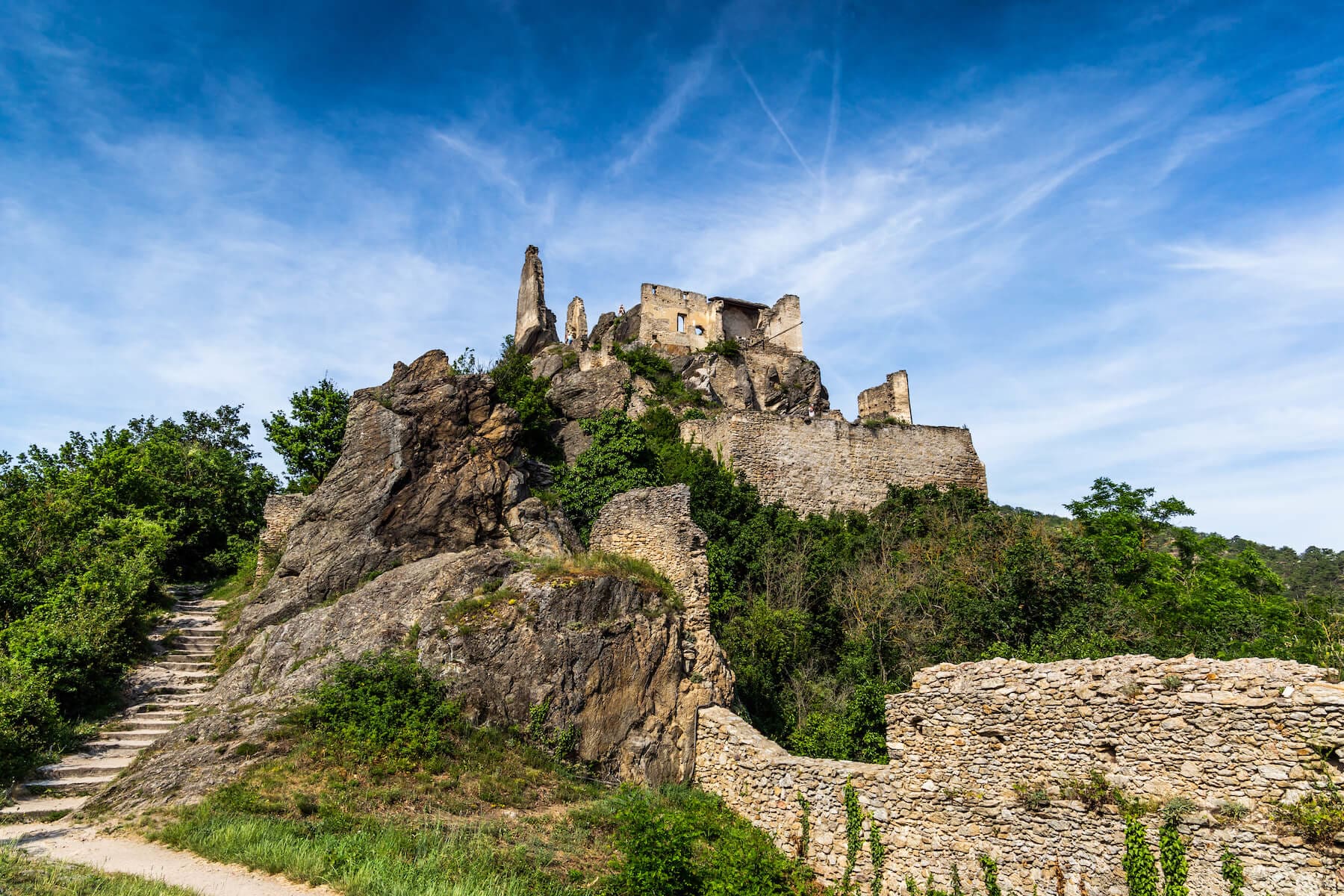
Dürnstein Castle Ruins
 Highlight of Wachau Valley
Highlight of Wachau ValleyHike to the dramatic ruins of a medieval castle built in 1100's.
The hike leading to the castle is steep, but the amazing view you are rewarded with makes it all worth while. The fascinating ruins are extensive and can be freely explored. The castle was made famous by its most illustrious prisoner, King Richard the Lionhearted of England, who was held there for ransom.
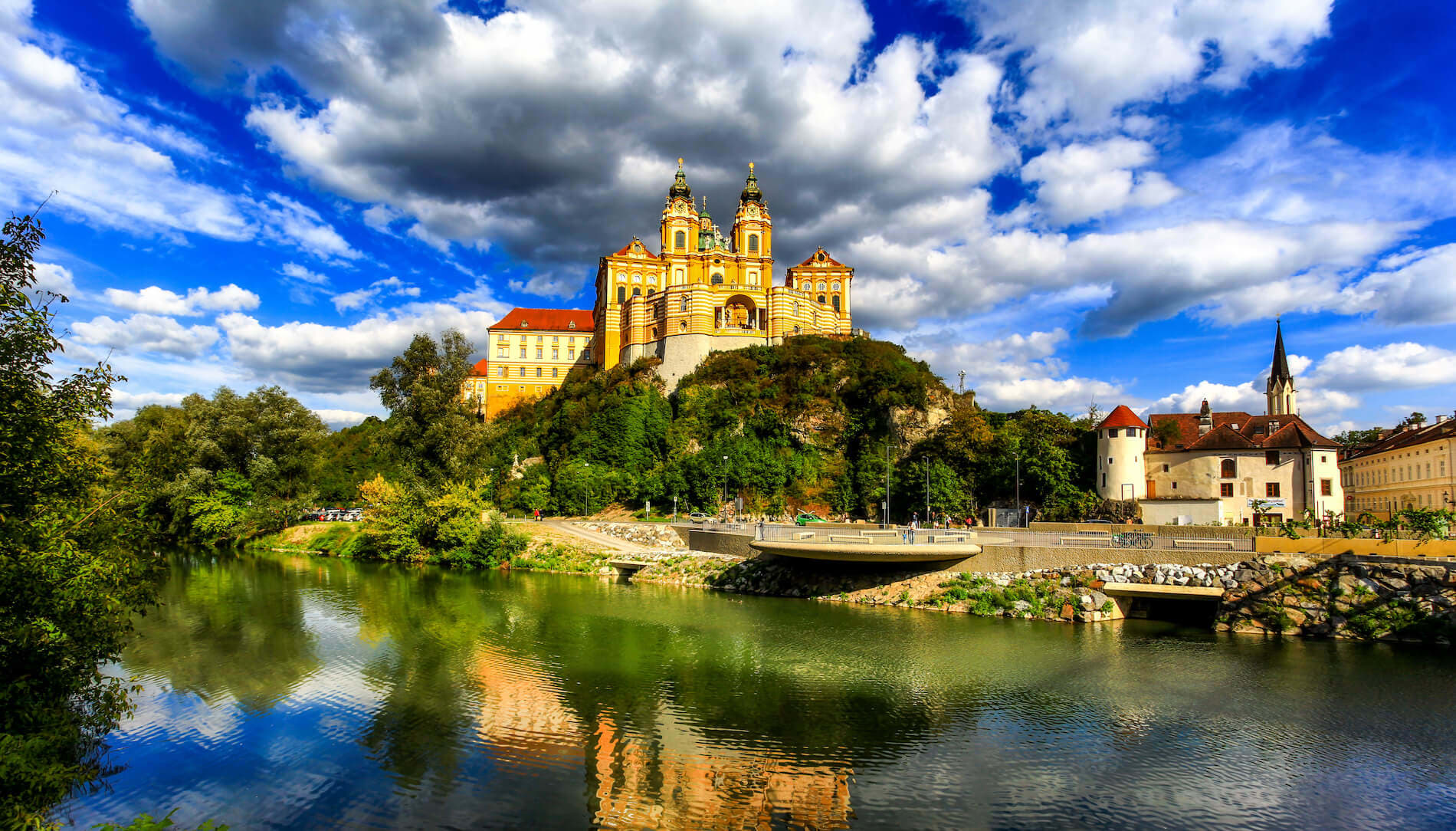
Melk Abbey
 Highlight of Wachau Valley
Highlight of Wachau ValleyTour a huge and splendid Baroque monastery.
Founded in 1089 when the Austrian duke gave one of his castles to Benedictine monks, Melk Abbey is now both a place of pilgrimage and a major tourist attraction. Visitors come for the museum of religious artifacts, the jaw-dropping library, and the sublime church. The town square below the abbey is also a great place for a meal or wine.
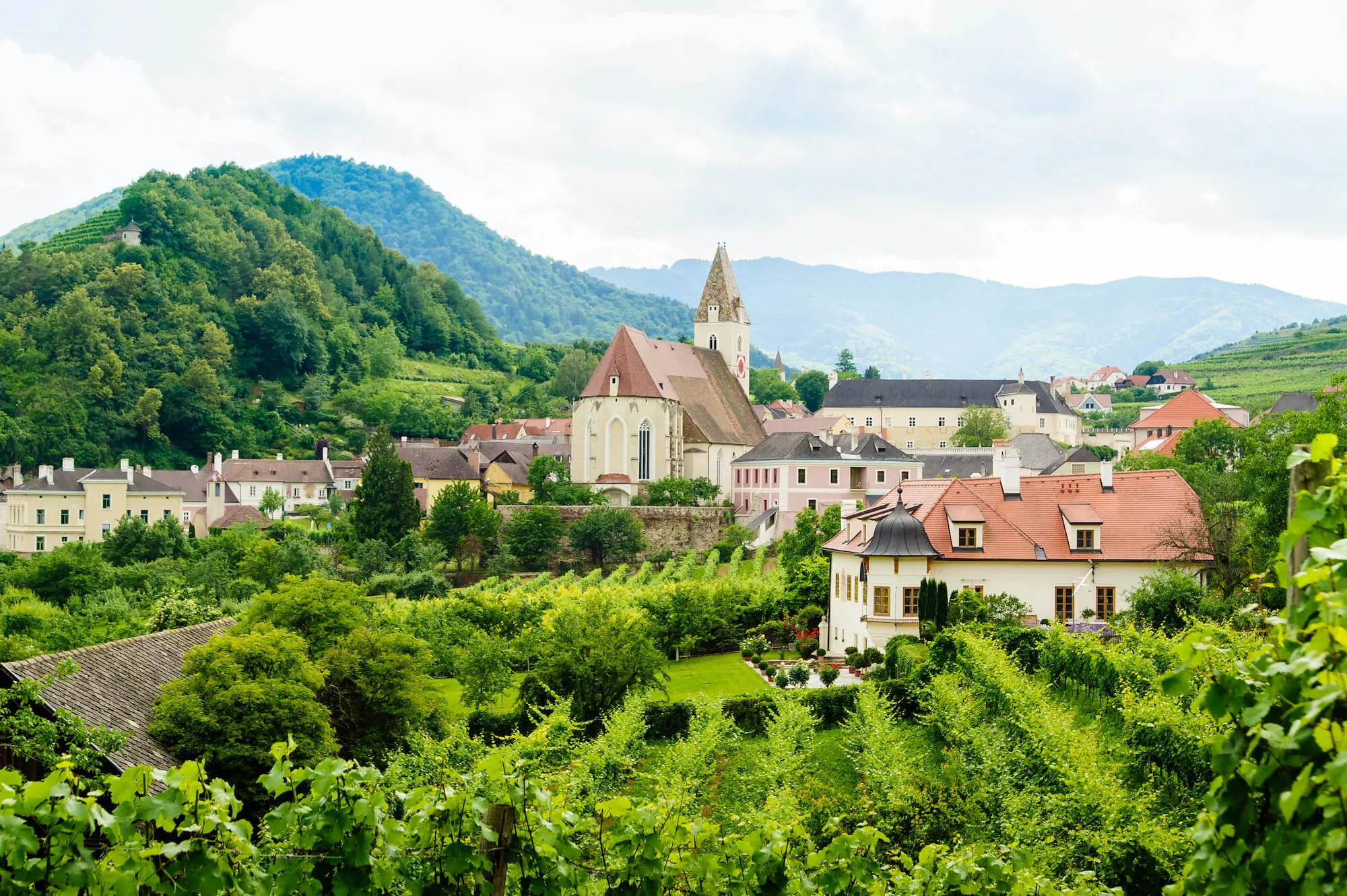
Spitz
 Highlight of Wachau Valley
Highlight of Wachau ValleyStop to taste the wine in a postcard-pretty town surrounded by vineyards.
Spitz is a favorite stop due to its bucolic atmosphere and abundance of wine taverns and restaurants. It is also home to the Tausendeimerberg or "House of a Thousand Buckets" (so named for the abundance of wine fields) and the castle ruins of Hinterhaus, which make for a nice (if steep) hike from the village.

Dürnstein
 Highlight of Wachau Valley
Highlight of Wachau ValleyExplore the twisting narrow lanes of this delightful monastery town.
Named for the castle that overlooks it, Dürnstein is probably the most-visited stop in the Wachau valley. Reached by an ancient tunnel leading from the boat docks, it is well-known for its wine as well as the beautiful blue church tower of its Augustinian monastery.

Dürnstein Castle Ruins
 Highlight of Wachau Valley
Highlight of Wachau ValleyHike to the dramatic ruins of a medieval castle built in 1100's.
The hike leading to the castle is steep, but the amazing view you are rewarded with makes it all worth while. The fascinating ruins are extensive and can be freely explored. The castle was made famous by its most illustrious prisoner, King Richard the Lionhearted of England, who was held there for ransom.

Melk Abbey
 Highlight of Wachau Valley
Highlight of Wachau ValleyTour a huge and splendid Baroque monastery.
Founded in 1089 when the Austrian duke gave one of his castles to Benedictine monks, Melk Abbey is now both a place of pilgrimage and a major tourist attraction. Visitors come for the museum of religious artifacts, the jaw-dropping library, and the sublime church. The town square below the abbey is also a great place for a meal or wine.

Spitz
 Highlight of Wachau Valley
Highlight of Wachau ValleyStop to taste the wine in a postcard-pretty town surrounded by vineyards.
Spitz is a favorite stop due to its bucolic atmosphere and abundance of wine taverns and restaurants. It is also home to the Tausendeimerberg or "House of a Thousand Buckets" (so named for the abundance of wine fields) and the castle ruins of Hinterhaus, which make for a nice (if steep) hike from the village.
prev
next

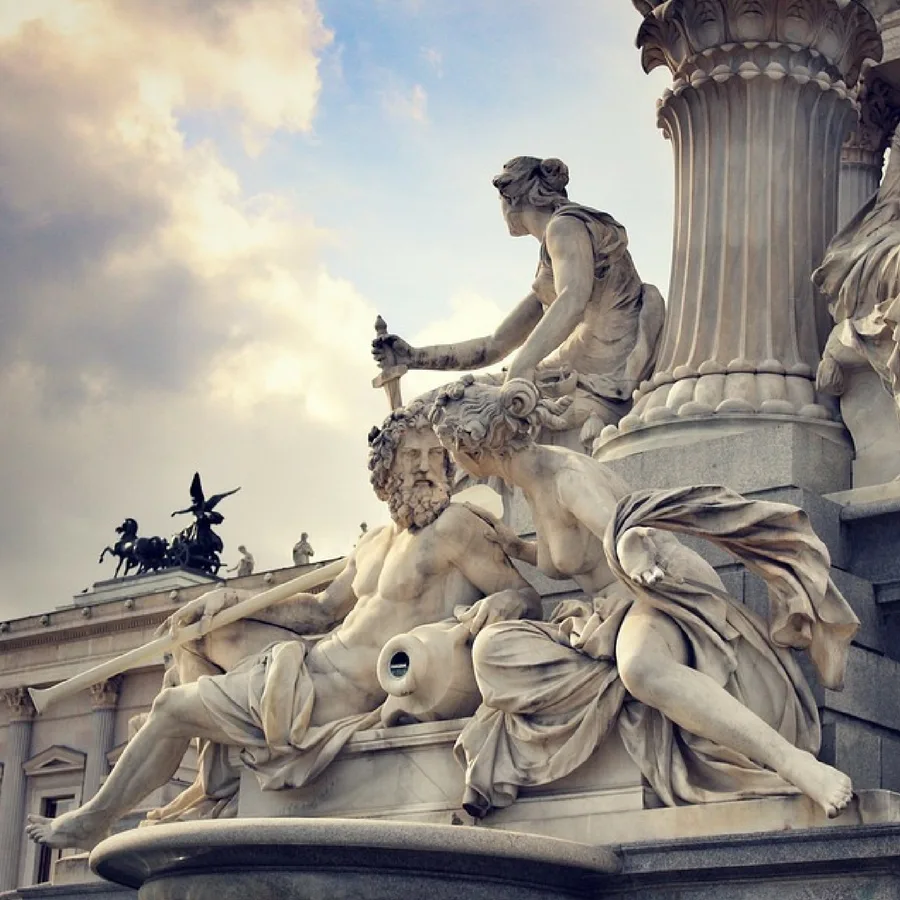
Day 8
Vienna
View More
Day 8
Vienna



Morning
Tour the Schönbrunn Palace
The magnificent Baroque palace of Schönbrunn is most famously associated with Empress Maria Theresa, who lived here surrounded by 16 little archdukes and duchesses who also happened to be her children. On your tour of the palace, you will see how Maria Theresa and other past imperial residents lived. No visit is complete without a stroll in the vast gardens surrounding the palace.

Schönbrunn Zoo
Join local families enjoying one of Europe's best zoos.
Show More

Schönbrunn Gardens
Get lost in the huge imperial gardens.
Show More

Schönbrunn Zoo
Join local families enjoying one of Europe's best zoos.
Show More

Schönbrunn Gardens
Get lost in the huge imperial gardens.
Show More

Schönbrunn Zoo
Join local families enjoying one of Europe's best zoos.
Show More

Schönbrunn Gardens
Get lost in the huge imperial gardens.
Show More
prev
next

Day 8
Vienna
View More


Schönbrunn Zoo
 Highlight of Schönbrunn Palace
Highlight of Schönbrunn PalaceJoin local families enjoying one of Europe's best zoos.
With an entrance directly connected to the Schönbrunn palace gardens, visiting the zoo can be a great addition to any trip to the palace. Founded as an imperial menagerie in 1752, it is the oldest continually operated zoo in the world, and today is home to many rare species such as giant pandas.
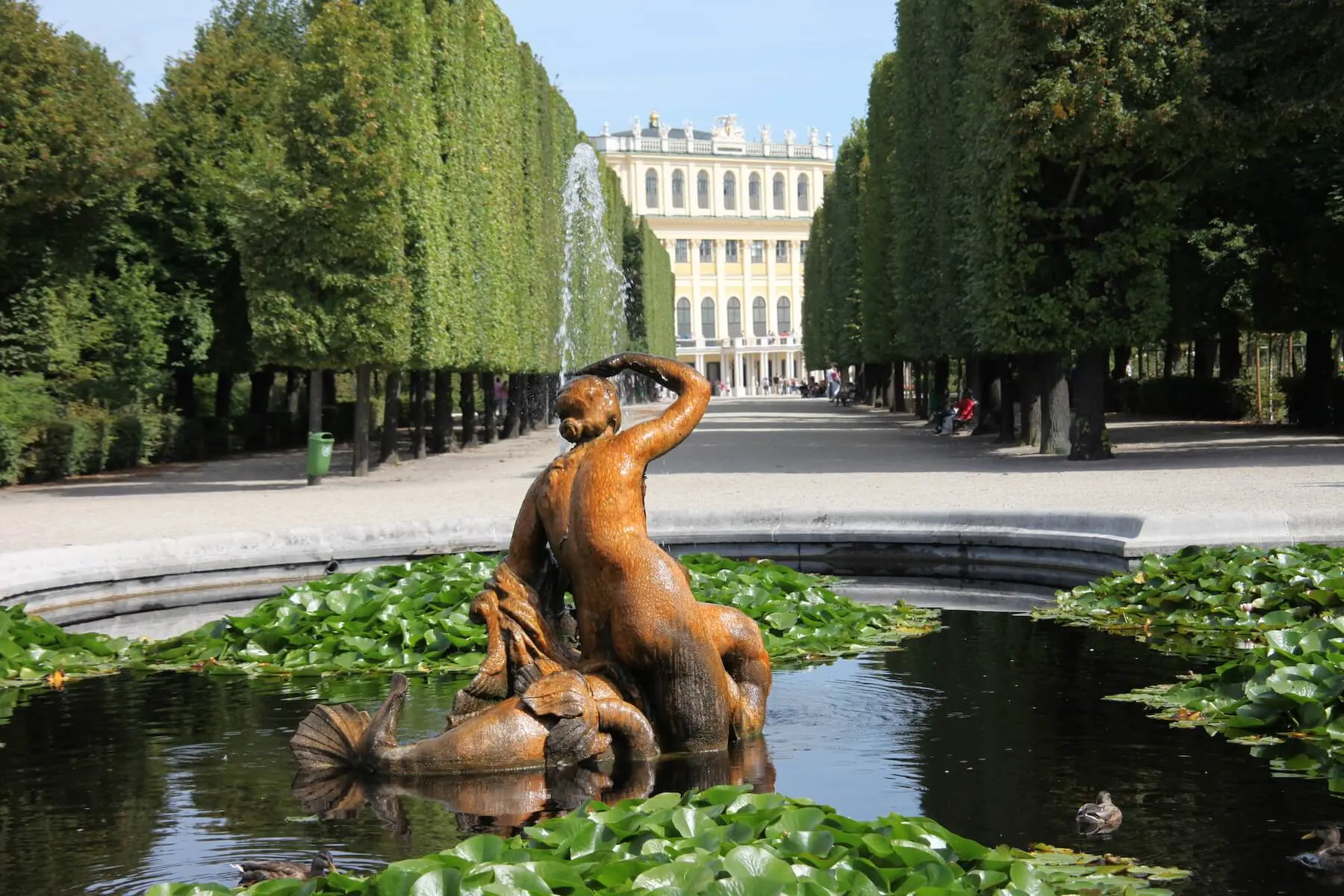
Schönbrunn Gardens
 Highlight of Schönbrunn Palace
Highlight of Schönbrunn PalaceGet lost in the huge imperial gardens.
The beautiful park is a mix of formal gardens and woodlands, and is dotted with enchanting statues & fountains, including a massive fountain of Neptune. The Gloriette pavilion sits on a rise opposite the palace and commands a wonderful view. Kids will love the labyrinth, racing to find the tower at the center of the maze.

Schönbrunn Zoo
 Highlight of Schönbrunn Palace
Highlight of Schönbrunn PalaceJoin local families enjoying one of Europe's best zoos.
With an entrance directly connected to the Schönbrunn palace gardens, visiting the zoo can be a great addition to any trip to the palace. Founded as an imperial menagerie in 1752, it is the oldest continually operated zoo in the world, and today is home to many rare species such as giant pandas.

Schönbrunn Gardens
 Highlight of Schönbrunn Palace
Highlight of Schönbrunn PalaceGet lost in the huge imperial gardens.
The beautiful park is a mix of formal gardens and woodlands, and is dotted with enchanting statues & fountains, including a massive fountain of Neptune. The Gloriette pavilion sits on a rise opposite the palace and commands a wonderful view. Kids will love the labyrinth, racing to find the tower at the center of the maze.

Schönbrunn Zoo
 Highlight of Schönbrunn Palace
Highlight of Schönbrunn PalaceJoin local families enjoying one of Europe's best zoos.
With an entrance directly connected to the Schönbrunn palace gardens, visiting the zoo can be a great addition to any trip to the palace. Founded as an imperial menagerie in 1752, it is the oldest continually operated zoo in the world, and today is home to many rare species such as giant pandas.

Schönbrunn Gardens
 Highlight of Schönbrunn Palace
Highlight of Schönbrunn PalaceGet lost in the huge imperial gardens.
The beautiful park is a mix of formal gardens and woodlands, and is dotted with enchanting statues & fountains, including a massive fountain of Neptune. The Gloriette pavilion sits on a rise opposite the palace and commands a wonderful view. Kids will love the labyrinth, racing to find the tower at the center of the maze.
prev
next


Day 9
Vienna to Budapest
View More
Day 9
Vienna to Budapest





8:40 AM
Transfer to Station by Taxi or Public Transport
Most trains depart from Vienna Main Station (Wien Hbf) station. If traveling to the west though, there is a good possibility you will leave from the west station (Wien Westbahnhof). Before spending money on a transfer, be sure to check whether your hotel is within easy walking distance. Also consider that public transport is the cheapest and sometimes fastest option. If staying at a hotel, they can order a reliable taxi. Some private transfers will even help with your bags. Uber is also available for those with the app.

Day 9
Vienna to Budapest
View More


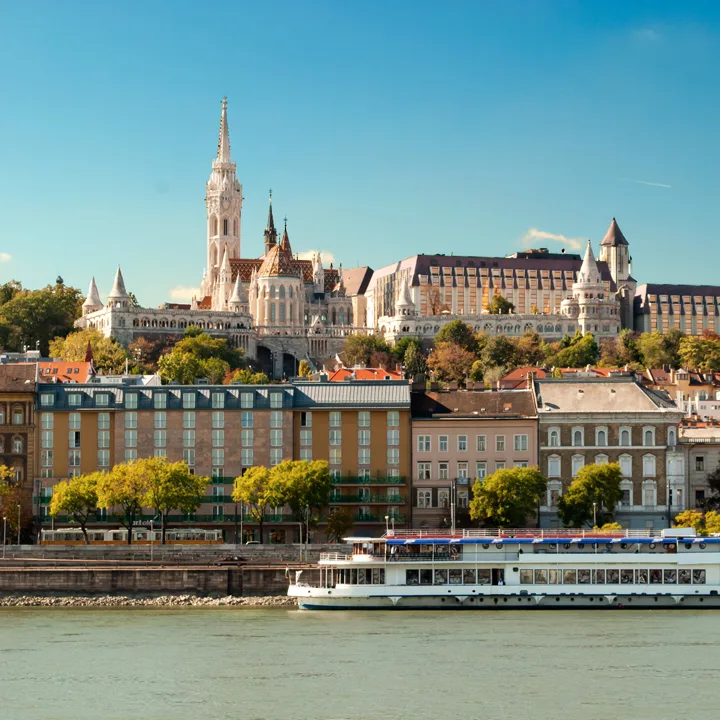
Day 10
Budapest
View More
Day 10
Budapest



9:00 AM - 12:30 PM
Best of Budapest: Half-Day Walking Tour of Highlights & Hidden Finds
During your tour you will take in a gorgeous vista of the city from the Fisherman's Bastion, explore the winding streets of the Castle District, gaze in awe at the striking interior of St. Stephen's Basilica, travel along the city's most elegant avenue and more. Along the way you will experience the city as a local does, stopping to check out intimate courtyards, enjoying a pastry and soaking in the ambiance of Budapest's most elegant cafes.

Day 10
Budapest
View More


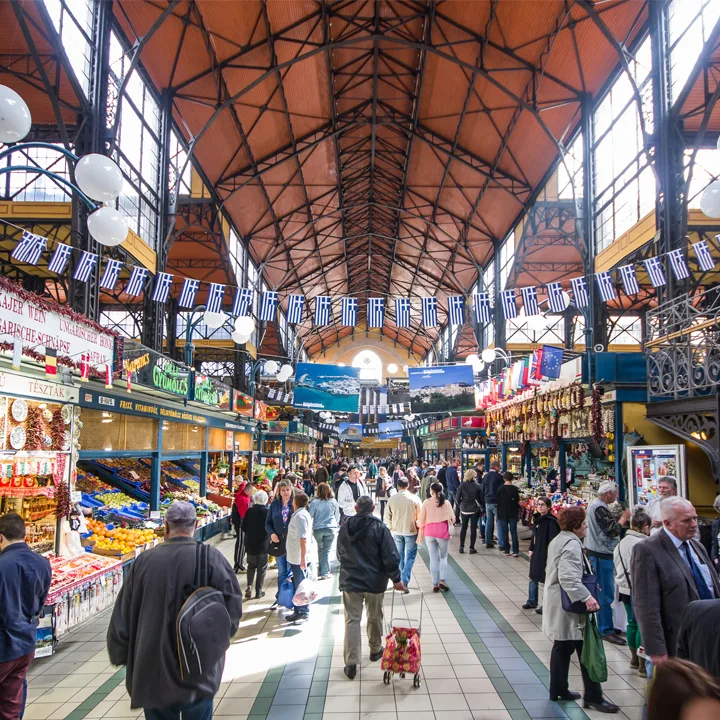
Day 11
Budapest
View More
Day 11
Budapest


Early Morning/Morning
Váci street and the Central Market
The Central Market Hall is a mezzanine shopping arcade first opened in 1897. Today the Central Market teems with activity like small shops and stands offer a remarkable assortment of goods, including fruits and vegetables, meats and cheeses, fish, flowers, and Hungarian specialties. There are also many souvenirs available on the second floor of the market.

Promenade
Discover why this pedestrian walkway along the Danube River, with it's beautiful views of the river and castle, is a favorite of both locals and visitors alike.
Show More

Central Market Hall
Shop in a huge market hall built in the late 19th century.
Show More

Váci Street (Váci utca)
Walk one of Budapest's main pedestrian thoroughfares, which is very popular with shoppers and tourists.
Show More

Promenade
Discover why this pedestrian walkway along the Danube River, with it's beautiful views of the river and castle, is a favorite of both locals and visitors alike.
Show More

Central Market Hall
Shop in a huge market hall built in the late 19th century.
Show More

Váci Street (Váci utca)
Walk one of Budapest's main pedestrian thoroughfares, which is very popular with shoppers and tourists.
Show More

Promenade
Discover why this pedestrian walkway along the Danube River, with it's beautiful views of the river and castle, is a favorite of both locals and visitors alike.
Show More
prev
next

Day 11
Budapest
View More


Promenade
 Highlight of Central Market & Váci Street
Highlight of Central Market & Váci StreetDiscover why this pedestrian walkway along the Danube River, with it's beautiful views of the river and castle, is a favorite of both locals and visitors alike.
This promenade above the river embankment was the place to see-and-be-seen in 19th century Budapest. Cafes and luxury hotels lined the promenade, taking advantage of stunning views of the castle. They were destroyed in WWII and replaced with large modern hotels, eliminating some of the charm. The view, however, is still incredible.
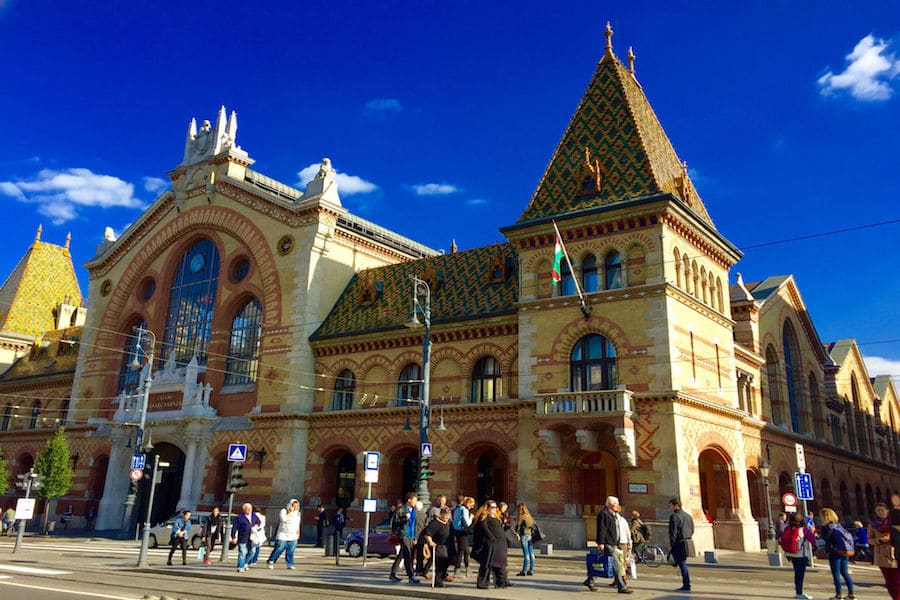
Central Market Hall
 Highlight of Central Market & Váci Street
Highlight of Central Market & Váci StreetShop in a huge market hall built in the late 19th century.
This restored neo-gothic Market Hall is a favorite with visitors but also still visited by locals for its outstanding food stands and grocery stalls on the ground floor. On the upper levels, you can shop for souvenirs and traditional Hungarian goods & crafts.

Váci Street (Váci utca)
 Highlight of Central Market & Váci Street
Highlight of Central Market & Váci StreetWalk one of Budapest's main pedestrian thoroughfares, which is very popular with shoppers and tourists.
The street is lined by shops, boutiques, cafés, and restaurants. Many elegant buildings line the street, most dating to the late19th century. Numerous courtyards and passageways branch off from the street. Although touristy, it is an integral part of the city and an interesting place to stroll.

Promenade
 Highlight of Central Market & Váci Street
Highlight of Central Market & Váci StreetDiscover why this pedestrian walkway along the Danube River, with it's beautiful views of the river and castle, is a favorite of both locals and visitors alike.
This promenade above the river embankment was the place to see-and-be-seen in 19th century Budapest. Cafes and luxury hotels lined the promenade, taking advantage of stunning views of the castle. They were destroyed in WWII and replaced with large modern hotels, eliminating some of the charm. The view, however, is still incredible.

Central Market Hall
 Highlight of Central Market & Váci Street
Highlight of Central Market & Váci StreetShop in a huge market hall built in the late 19th century.
This restored neo-gothic Market Hall is a favorite with visitors but also still visited by locals for its outstanding food stands and grocery stalls on the ground floor. On the upper levels, you can shop for souvenirs and traditional Hungarian goods & crafts.

Váci Street (Váci utca)
 Highlight of Central Market & Váci Street
Highlight of Central Market & Váci StreetWalk one of Budapest's main pedestrian thoroughfares, which is very popular with shoppers and tourists.
The street is lined by shops, boutiques, cafés, and restaurants. Many elegant buildings line the street, most dating to the late19th century. Numerous courtyards and passageways branch off from the street. Although touristy, it is an integral part of the city and an interesting place to stroll.

Promenade
 Highlight of Central Market & Váci Street
Highlight of Central Market & Váci StreetDiscover why this pedestrian walkway along the Danube River, with it's beautiful views of the river and castle, is a favorite of both locals and visitors alike.
This promenade above the river embankment was the place to see-and-be-seen in 19th century Budapest. Cafes and luxury hotels lined the promenade, taking advantage of stunning views of the castle. They were destroyed in WWII and replaced with large modern hotels, eliminating some of the charm. The view, however, is still incredible.
prev
next


Day 12
Budapest
View More
Day 12
Budapest



Morning
Hungarian Parliament and its Surroundings
The Hungarian Parliament building is a magnificent sight as it rises above the waters of the Danube, and the interior is also quite jaw-dropping. As a visitor, you may even feel a bit overwhelmed by the sumptuous décor and attention-to-detail. You could be forgiven for expecting a queen to arrive or an aristocratic ball to break out at any moment.

Former Museum of Ethnography
This building once housed the Hungarian Supreme Court and the Ethnographic museum. The museum is relocating to City Park and will open in 2022.
Show More

Shoes on the Danube Bank
Reflect at a waterside sculpture of shoes memorializing the victims of fascism who died at this spot.
Show More

Hungarian Parliament
Tour this massive and stunning Gothic Revival–style edifice with a guide.
Show More

Former Museum of Ethnography
This building once housed the Hungarian Supreme Court and the Ethnographic museum. The museum is relocating to City Park and will open in 2022.
Show More

Shoes on the Danube Bank
Reflect at a waterside sculpture of shoes memorializing the victims of fascism who died at this spot.
Show More

Hungarian Parliament
Tour this massive and stunning Gothic Revival–style edifice with a guide.
Show More

Former Museum of Ethnography
This building once housed the Hungarian Supreme Court and the Ethnographic museum. The museum is relocating to City Park and will open in 2022.
Show More
prev
next

Day 12
Budapest
View More


Former Museum of Ethnography
 Highlight of Hungarian Parliament & Nearby
Highlight of Hungarian Parliament & NearbyThis building once housed the Hungarian Supreme Court and the Ethnographic museum. The museum is relocating to City Park and will open in 2022.
It was the second place winner in the competition to design the Hungarian Parliament. Many believe it is as beautiful at the Parliament, especially it's interiors.
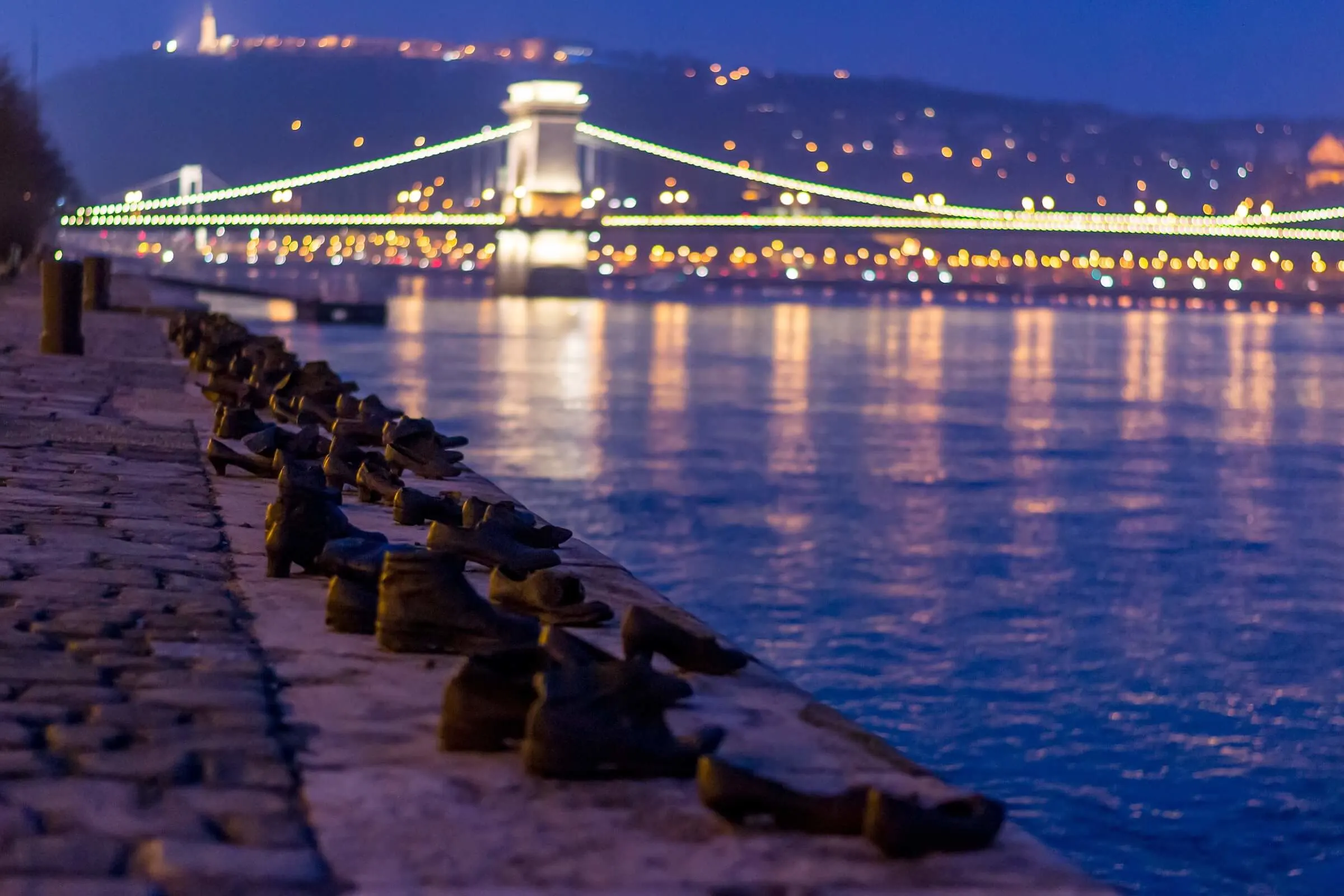
Shoes on the Danube Bank
 Highlight of Hungarian Parliament & Nearby
Highlight of Hungarian Parliament & NearbyReflect at a waterside sculpture of shoes memorializing the victims of fascism who died at this spot.
This moving memorial consists of empty shoes by the riverbank. Near the end of World War II a fascist party took control in Hungary. Jews were lined up along the river bank, forced to step out of their shoes (so they could be collected later), and then machine gunned into the river.

Hungarian Parliament
 Highlight of Hungarian Parliament & Nearby
Highlight of Hungarian Parliament & NearbyTour this massive and stunning Gothic Revival–style edifice with a guide.
The Parliament is ostentatious, but undeniably grand and beautiful. A teeming mass of spires, arches, and towers surrounds the central dome, beneath which the royal crown of Hungary lies under armed guard. Tours of the lavish interiors include the crown, parliament chambers, and grand entry hall. Pre-purchasing tickets is recommended as they often sell out well in advance.

Former Museum of Ethnography
 Highlight of Hungarian Parliament & Nearby
Highlight of Hungarian Parliament & NearbyThis building once housed the Hungarian Supreme Court and the Ethnographic museum. The museum is relocating to City Park and will open in 2022.
It was the second place winner in the competition to design the Hungarian Parliament. Many believe it is as beautiful at the Parliament, especially it's interiors.

Shoes on the Danube Bank
 Highlight of Hungarian Parliament & Nearby
Highlight of Hungarian Parliament & NearbyReflect at a waterside sculpture of shoes memorializing the victims of fascism who died at this spot.
This moving memorial consists of empty shoes by the riverbank. Near the end of World War II a fascist party took control in Hungary. Jews were lined up along the river bank, forced to step out of their shoes (so they could be collected later), and then machine gunned into the river.

Hungarian Parliament
 Highlight of Hungarian Parliament & Nearby
Highlight of Hungarian Parliament & NearbyTour this massive and stunning Gothic Revival–style edifice with a guide.
The Parliament is ostentatious, but undeniably grand and beautiful. A teeming mass of spires, arches, and towers surrounds the central dome, beneath which the royal crown of Hungary lies under armed guard. Tours of the lavish interiors include the crown, parliament chambers, and grand entry hall. Pre-purchasing tickets is recommended as they often sell out well in advance.

Former Museum of Ethnography
 Highlight of Hungarian Parliament & Nearby
Highlight of Hungarian Parliament & NearbyThis building once housed the Hungarian Supreme Court and the Ethnographic museum. The museum is relocating to City Park and will open in 2022.
It was the second place winner in the competition to design the Hungarian Parliament. Many believe it is as beautiful at the Parliament, especially it's interiors.
prev
next


Day 13
Budapest
View More
Day 13
Budapest


Morning
Visiting the Jewish Quarter
Budapest was once the site of one of Europe's largest and most vibrant Jewish communities and contains the world's second largest synagogue – the Dohány Street Synagogue. A visit there is an impressive reminder of the wealth and influence the Jewish community in Hungary once possessed. A small but vibrant Jewish population still inhabits the Jewish Quarter today.

Szimpla Kert
Discover Budapest's most unique form of nightlife - pubs located in the ruins of old buildings!
Show More

Holocaust Memorial Center
Learn about the Holocaust in a former synagogue which honors Hungarian Jews killed in WWII.
Show More

Great Synagogue
Stare in awe at Europe's largest synagogue (and the second largest in the world).
Show More

Szimpla Kert
Discover Budapest's most unique form of nightlife - pubs located in the ruins of old buildings!
Show More

Holocaust Memorial Center
Learn about the Holocaust in a former synagogue which honors Hungarian Jews killed in WWII.
Show More

Great Synagogue
Stare in awe at Europe's largest synagogue (and the second largest in the world).
Show More

Szimpla Kert
Discover Budapest's most unique form of nightlife - pubs located in the ruins of old buildings!
Show More
prev
next

Day 13
Budapest
View More

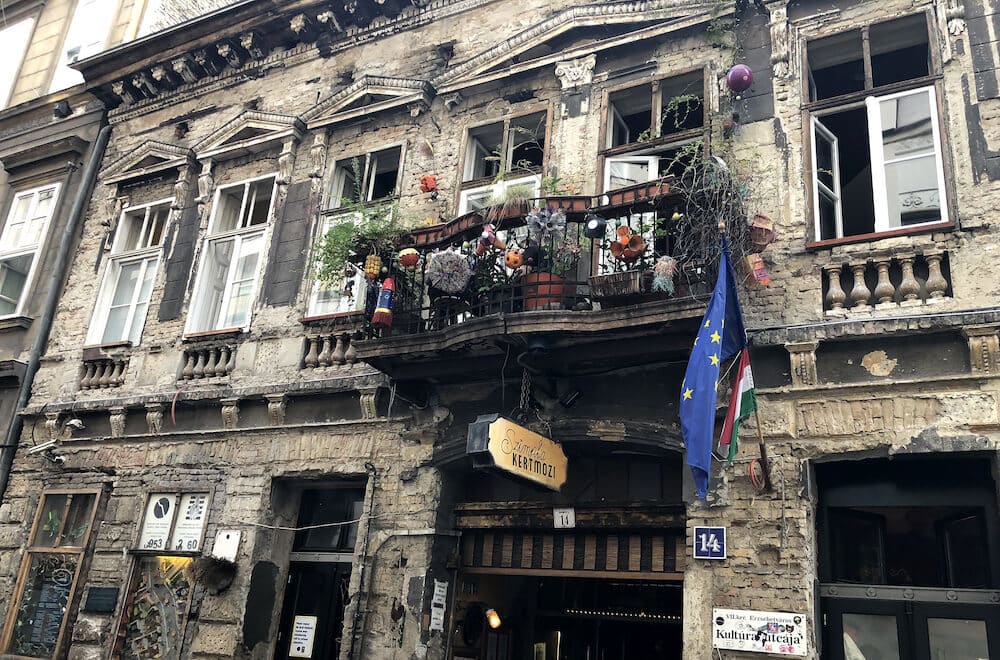
Szimpla Kert
 Highlight of Jewish Quarter
Highlight of Jewish QuarterDiscover Budapest's most unique form of nightlife - pubs located in the ruins of old buildings!
Szimpla Kert was the first pub located in a ruin, and it started a trend that is now a Budapest institution. These pubs have an eclectic vibe and are a great place to mix with the locals as well as other visitors. The concept dates back to the early 2000s when entrepreneurs took over abandoned spaces within dilapidated buildings for underground events. The 7th district, i.e. the Jewish Quarter, is the best place to find them.

Holocaust Memorial Center
 Highlight of Jewish Quarter
Highlight of Jewish QuarterLearn about the Holocaust in a former synagogue which honors Hungarian Jews killed in WWII.
The refurbished 1920s synagogue now serves as a museum and memorial for Hungarian Jewish victims of the Holocaust. It also functions as a documentation center. Note, it is actually not located in the Jewish Quarter, which is in Budapest's 7th District, but the nearby 9th District.
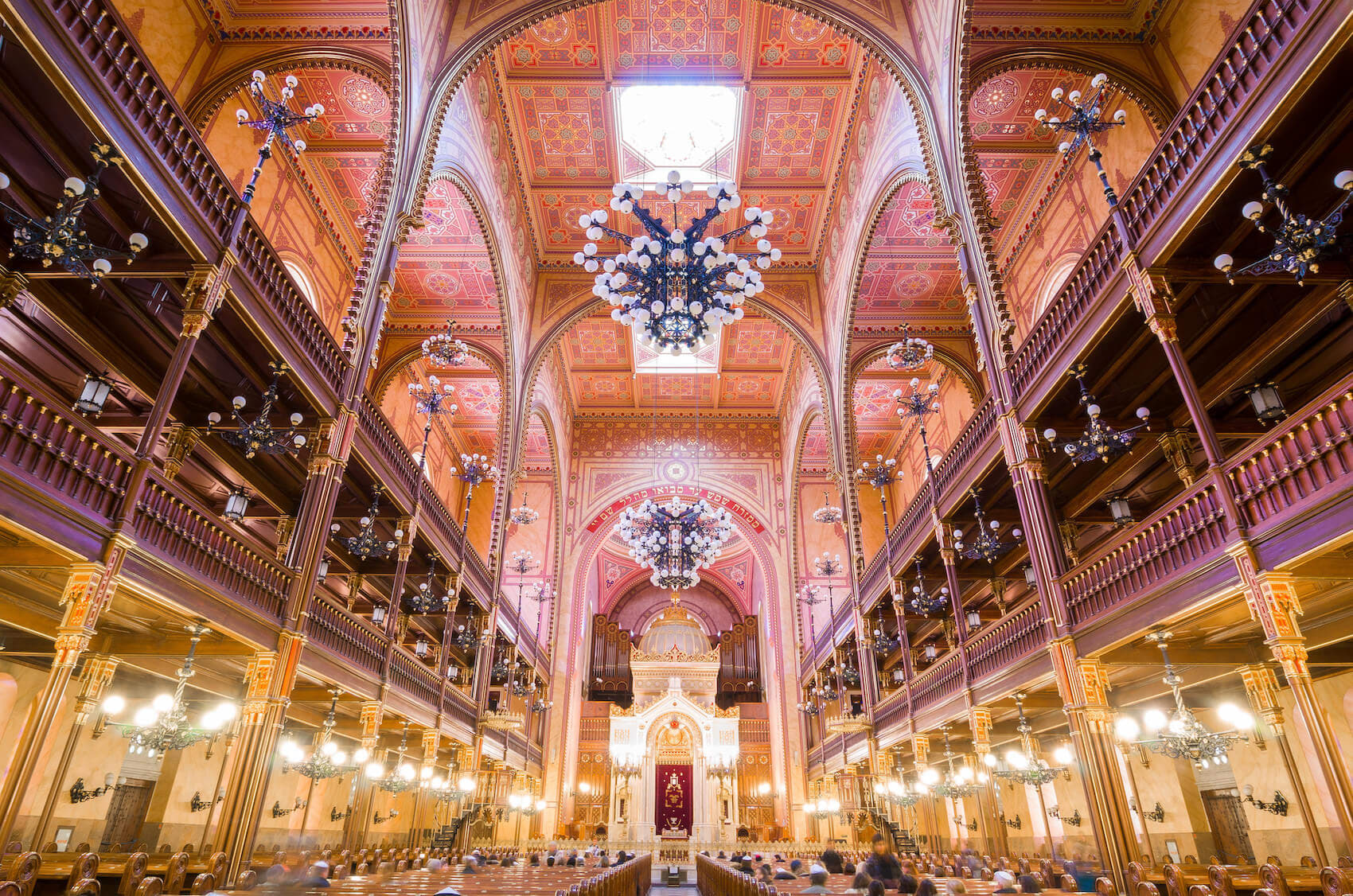
Great Synagogue
 Highlight of Jewish Quarter
Highlight of Jewish QuarterStare in awe at Europe's largest synagogue (and the second largest in the world).
Also known as the Dohány Street Synagogue, it possesses a striking Byzantine Moorish style exterior with an ornate dome, and an opulent interior. Adjacent to it are a memorial to the Holocaust in the form of a weeping willow, and a museum of Jewish culture. Entry is by guided tour only, although wait times can be very long so booking early is recommended.

Szimpla Kert
 Highlight of Jewish Quarter
Highlight of Jewish QuarterDiscover Budapest's most unique form of nightlife - pubs located in the ruins of old buildings!
Szimpla Kert was the first pub located in a ruin, and it started a trend that is now a Budapest institution. These pubs have an eclectic vibe and are a great place to mix with the locals as well as other visitors. The concept dates back to the early 2000s when entrepreneurs took over abandoned spaces within dilapidated buildings for underground events. The 7th district, i.e. the Jewish Quarter, is the best place to find them.

Holocaust Memorial Center
 Highlight of Jewish Quarter
Highlight of Jewish QuarterLearn about the Holocaust in a former synagogue which honors Hungarian Jews killed in WWII.
The refurbished 1920s synagogue now serves as a museum and memorial for Hungarian Jewish victims of the Holocaust. It also functions as a documentation center. Note, it is actually not located in the Jewish Quarter, which is in Budapest's 7th District, but the nearby 9th District.

Great Synagogue
 Highlight of Jewish Quarter
Highlight of Jewish QuarterStare in awe at Europe's largest synagogue (and the second largest in the world).
Also known as the Dohány Street Synagogue, it possesses a striking Byzantine Moorish style exterior with an ornate dome, and an opulent interior. Adjacent to it are a memorial to the Holocaust in the form of a weeping willow, and a museum of Jewish culture. Entry is by guided tour only, although wait times can be very long so booking early is recommended.

Szimpla Kert
 Highlight of Jewish Quarter
Highlight of Jewish QuarterDiscover Budapest's most unique form of nightlife - pubs located in the ruins of old buildings!
Szimpla Kert was the first pub located in a ruin, and it started a trend that is now a Budapest institution. These pubs have an eclectic vibe and are a great place to mix with the locals as well as other visitors. The concept dates back to the early 2000s when entrepreneurs took over abandoned spaces within dilapidated buildings for underground events. The 7th district, i.e. the Jewish Quarter, is the best place to find them.
prev
next


Day 14
Depart Budapest
View More
Day 14
Depart Budapest

To Be Determined
Transfer to Airport by Taxi
Budapest has one main airport, Budapest Ferenc Liszt International Airport, where almost all visitors depart. Your hotel can arrange a reliable taxi (there is no Uber in Budapest). You can also arrange a private transfer. If you are picked up about two hours and forty-five minutes before your departure time, you should arrive at the airport with about two hours to spare, depending on traffic. If you are leaving during rush hour, you may want to budget an extra fifteen to thirty minutes.

Day 14
Depart Budapest
View More


What's Included In Your Trip

Pre-Paid Tours and Activities:
- Prague Castle & Royal Route Guided Walk
- Guided Walk through Vienna's Inner City
- Best of Budapest: Half-Day Walking Tour of Highlights & Hidden Finds

Pre-Paid Transportation:
- 2nd Class Train Tickets from Prague to Vienna
- 2nd Class Train Tickets from Vienna to Budapest
- Public Transport Tickets for Budapest and Vienna
- Private Transfer from the Budapest Rail Station

Accommodation:
- 5 nights at a hotel of your choice in Prague
- 5 nights at a hotel of your choice in Vienna
- 6 nights at a hotel of your choice in Budapest

Go Real Travel Mobile App:
- Itinerary Plan & Reservations Info
- Points of Interest
- Detailed Travel Information
- Maps & Directions
Other Trips You May Like

10 Days
From$2249USD
Perfect Whirlwind Itinerary to Prague, Salzburg, Vienna & Budapest

Czech Republic, Austria, Hungary

12 Days
From$2290USD
Enchanting Central Europe: Prague, Salzburg, Vienna, and Budapest

Czech Republic, Austria, Hungary

12 Days
From$2350USD

10 Days
From$1799USD
Central European Rhapsody: A Cultural and Historical Odyssey

Czech Republic, Austria, Hungary

7 Days
From$1489USD

15 Days
From$2750USD
Prague, Vienna, and Budapest, 15 Days of Must See Sights & Local Scenes

Czech Republic, Austria, Hungary

8 Days
From$1425USD
Enchanting Central Europe: 8-Days in Prague, Vienna & Budapest

Czech Republic, Austria, Hungary

12 Days
From$2675USD
Jewish Heritage and Scenic Rivers: A Journey through Prague, Vienna, and Budapest

Hungary, Austria, Czech Republic

12 Days
From$2200USD
A 12-Day Prague, Vienna, Budapest, and Bratislava Itinerary

Czech Republic, Austria, Slovakia, Hungary

10 Days
From$2249USD
Perfect Whirlwind Itinerary to Prague, Salzburg, Vienna & Budapest

Czech Republic, Austria, Hungary

12 Days
From$2290USD
Enchanting Central Europe: Prague, Salzburg, Vienna, and Budapest

Czech Republic, Austria, Hungary

12 Days
From$2350USD

10 Days
From$1799USD
Central European Rhapsody: A Cultural and Historical Odyssey

Czech Republic, Austria, Hungary

7 Days
From$1489USD

15 Days
From$2750USD
Prague, Vienna, and Budapest, 15 Days of Must See Sights & Local Scenes

Czech Republic, Austria, Hungary

8 Days
From$1425USD
Enchanting Central Europe: 8-Days in Prague, Vienna & Budapest

Czech Republic, Austria, Hungary

12 Days
From$2675USD
Jewish Heritage and Scenic Rivers: A Journey through Prague, Vienna, and Budapest

Hungary, Austria, Czech Republic

12 Days
From$2200USD
A 12-Day Prague, Vienna, Budapest, and Bratislava Itinerary

Czech Republic, Austria, Slovakia, Hungary
prev
next
Featured Blogs
prev
next
Our Customers Say It Best
Otto Chuy, Los Angeles, California
I am still surprised how everything worked as planned, without a hitch. All instructions in your itinerary were precise and correct. Your suggestions and comments in each of the locations we went to were very helpful. All your guides, without exception, were wonderful and exactly on time. 

Kathy Mongeau, Ottawa, Ontario
My sister, Ann Ibberson, and I have been back home for a few weeks now and still go on and on about our fabulous trip. We were just blown away in every respect. Given the fact that we only had 1 ½ weeks, you had everything arranged for us so efficiently and your contacts who we dealt with for transfers, tours, hotels were extremely professional and personable. Things could not have gone better. 

Clive Andrew, Brisbane, Queensland
Just a quick note to let you know that I am back home now after probably the best overseas holiday that I have ever had, in no small part due to your very capable organization booking of hotels, tours, & trains. There was just nothing that went wrong with the timings etc. 

Malini Dutta, Boston, Massachusetts
We can't thank you enough for the detailed plans, maps, and suggestions. It really felt that someone was holding our hands and showing us around. We had all the excitement of discovering foreign lands, with none of the problems that can happen while negotiating unfamiliar places. In fact, all the cities felt like home within a few hours of arriving and exploring. 

Bev and Mark Frankel, Williamsburg, Virginia
We could not be more pleased with Go Real Travel! You took the guess work out of things like public transport but still managed to allow us the freedom to tour as we wanted. Our guides were exceptional and every time I saw a Viking Cruise tour of 25 people, I realized the quality experience we were getting with Go Real. 

Marianne Strydom, Paarl, South Africa
I just wanted to thank you for organizing an amazing trip for me – I packed in so much in such a short period of time and everything was just perfect. The way you do things makes it possible to really get to know the destination, which for me as a travel agent could not have been better. 

Otto Chuy, Los Angeles, California
I am still surprised how everything worked as planned, without a hitch. All instructions in your itinerary were precise and correct. Your suggestions and comments in each of the locations we went to were very helpful. All your guides, without exception, were wonderful and exactly on time. 

Kathy Mongeau, Ottawa, Ontario
My sister, Ann Ibberson, and I have been back home for a few weeks now and still go on and on about our fabulous trip. We were just blown away in every respect. Given the fact that we only had 1 ½ weeks, you had everything arranged for us so efficiently and your contacts who we dealt with for transfers, tours, hotels were extremely professional and personable. Things could not have gone better. 

Clive Andrew, Brisbane, Queensland
Just a quick note to let you know that I am back home now after probably the best overseas holiday that I have ever had, in no small part due to your very capable organization booking of hotels, tours, & trains. There was just nothing that went wrong with the timings etc. 

Malini Dutta, Boston, Massachusetts
We can't thank you enough for the detailed plans, maps, and suggestions. It really felt that someone was holding our hands and showing us around. We had all the excitement of discovering foreign lands, with none of the problems that can happen while negotiating unfamiliar places. In fact, all the cities felt like home within a few hours of arriving and exploring. 

Bev and Mark Frankel, Williamsburg, Virginia
We could not be more pleased with Go Real Travel! You took the guess work out of things like public transport but still managed to allow us the freedom to tour as we wanted. Our guides were exceptional and every time I saw a Viking Cruise tour of 25 people, I realized the quality experience we were getting with Go Real. 

Marianne Strydom, Paarl, South Africa
I just wanted to thank you for organizing an amazing trip for me – I packed in so much in such a short period of time and everything was just perfect. The way you do things makes it possible to really get to know the destination, which for me as a travel agent could not have been better. 



Explore cities in more detail
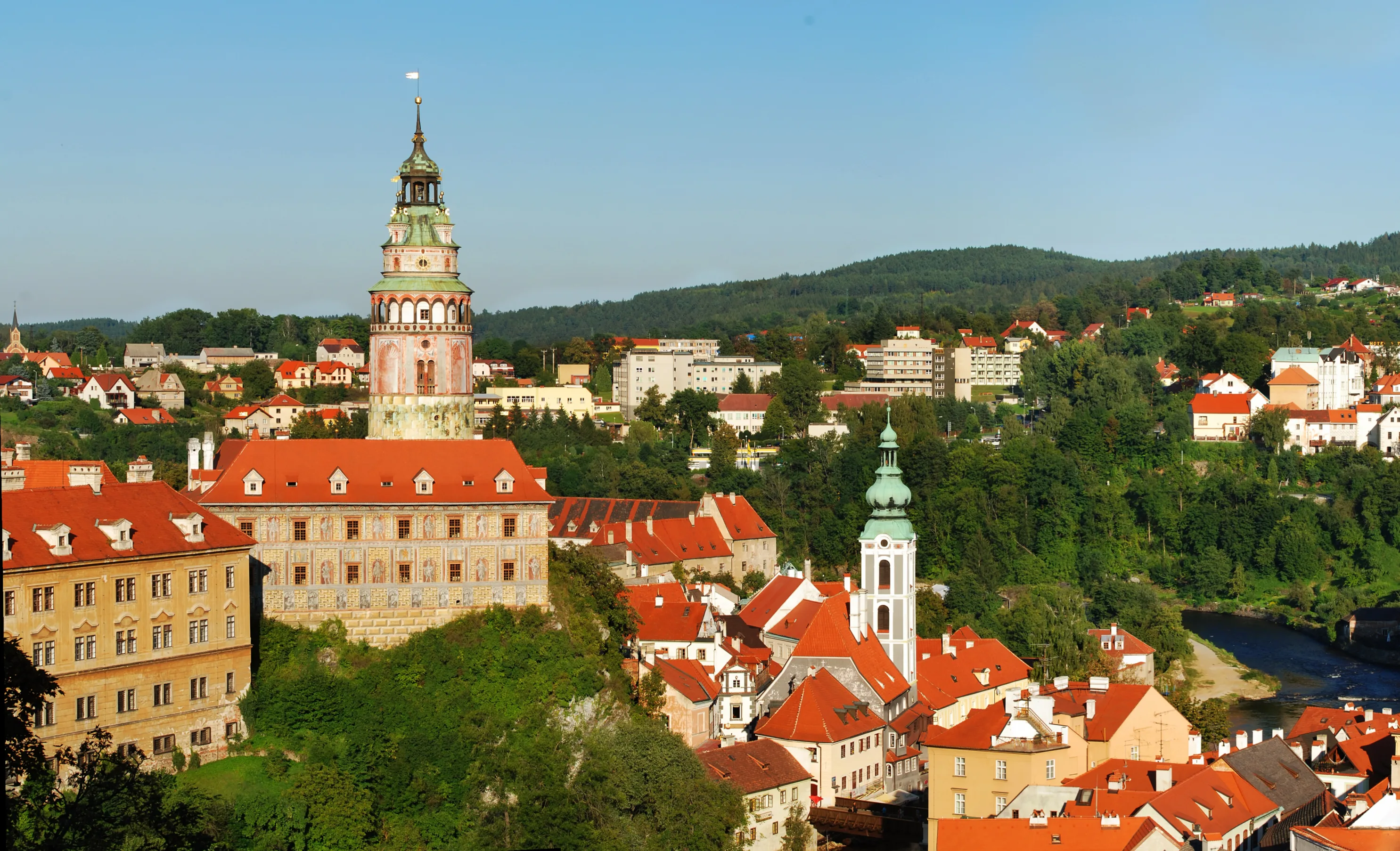
Cesky Krumlov
Cesky Krumlov is a charming little town in South Bohemia. It might be small, but it’s full of whimsical character and mystery. Walking through the narrow streets and across the bridge, the views of the medieval Cesky Krumlov Castle will take your breath away. At night, street musicians serenade visitors on the bridge where you can dance beneath the stars and the watchful eye of the magnificent tower. Dozens of unique local artisan shops, cafes, and restaurants are woven among the winding streets. In the summer, the city is lush with life and greenery. Rafters race down the river, stopping in the center along the way to enjoy a hearty meal before continuing their journey. In the winter, the main square transforms into a magnificent Christmas market and light blankets of snow cover the rooftops. This quaint little town will exceed your expectations and you may never want to leave.
Read More
Learn About Cesky Krumlov
Build Cesky Krumlov Trip

Dresden
Nearly every wall and rooftop in Dresden seems to be finished with a flourish. Defined by its ornamental baroque architecture, a power statement of Saxon royalty, Dresden is made all the more miraculous considering the city was leveled by firebombing in WWII. After the war, the city was reconstructed, brick by painstaking brick. Even under East German-Soviet rule, which usually eschewed frivolous design, buildings like the Semper Opera House were pieced back to their former glory. Restoration of the majestic Zwinger Palace and bell domed Church of Our Lady slowly followed, with the Frauenkirche only fully repaired in 2005. Arguably there is no other city in Europe that cherishes its hard-won architecture as much as Dresden. Although it is a compact city, so many of its buildings will stop you in your tracks that architecture fans will easily lose a whole day in the Old Town area. Especially during the winter months, Dresden sparkles with a joyous, uplifting ambiance. The city is recognized as having the best-ever Christmas market in all of Europe. Between the twinkling lights, the scent of hot wine and gingerbread, and the towering Christmas tree, it’s worth going out of your way to see Dresden at this time of year.
Read More
Learn About Dresden
Build Dresden Trip

Nuremberg
One of the most authentic, storied German destinations, Nuremberg's picturesque old town, glorious castle, and buzzing Christmas Market makes this city a time-true classic. The ideal gateway to old Bavaria, Nuremberg offers a primer in German history before you embark on the lovely journey through old Bavaria, known as the Romantic Road. Considered the capital of the Holy Roman Empire in the middle ages, Nuremberg would have felt like the center of the world as a procession of kings and emperors passed through its magnificent gates. When the German Renaissance came, Nuremberg was at its heart. Albrecht Dürer, the great German master artist, was born here, and Martin Luther called Nuremberg Germany's 'eyes and ears'. Skip forward a few centuries, and the city took a dark turn, as Nuremberg became a gathering point for the German National Socialists. Slightly outside of town, you can still find the Nazi Party Rallying Grounds, a sobering reminder of the not so distant past. If it all gets too heavy, you can end the day with a glass of rotbier (red beer) and mull it over. Nuremberg is a must-see for anyone who wants to delve into Germany's past.
Read More
Learn About Nuremberg
Build Nuremberg Trip

Prague
The city of Prague is indisputably the gem of Central Europe. Full of history, culture, and classic Czech pubs around every corner, Prague is teeming with nooks and crannies just waiting to be discovered. The narrow cobblestone streets and warm red rooftops give the city a homey feel, while the well-preserved medieval architecture transports you back in time. Walking across the Charles Bridge with the view of the Prague Castle will make you feel like you’re living in a fairytale, and you might as well be. As an up-and-coming destination, Prague is a perfect mix of classic and modern. New trendy cafes and bistros are always popping up, and you can always find a group of lively locals chowing down on goulash and quaffing pivo (the best beer in Europe!) at traditional Czech restaurants across the city. The clash of modernity and tradition, preservation and innovation, gives this city a mysterious air that you won’t soon forget.
Read More
Learn About Prague
Build Prague Trip

Vienna
Artistic and musical, historical and elegant, Vienna is the definition of class. The seat of the Habsburg monarchy for over six centuries, it's no wonder this city is still fit for royalty. Baroque buildings and imperial palaces dominate the cityscape, while locals stride gracefully through the streets, likely on their way to a classical music concert or art exhibition. Visitors from all over the world flock to Schonbrunn Palace, historical museums, and local eateries for authentic Viennese schnitzel. Vienna is also home to world-class wining and dining. Famous dishes include Wiener schnitzel, Tafelspitz (prime boiled beef), and apfelstrudel (apple strudel), all of which pair well with a glass of fine Austrian wine. No matter how long you spend in Vienna, you'll leave with a new appreciation for the finer things in life.
Read More
Learn About Vienna
Build Vienna Trip
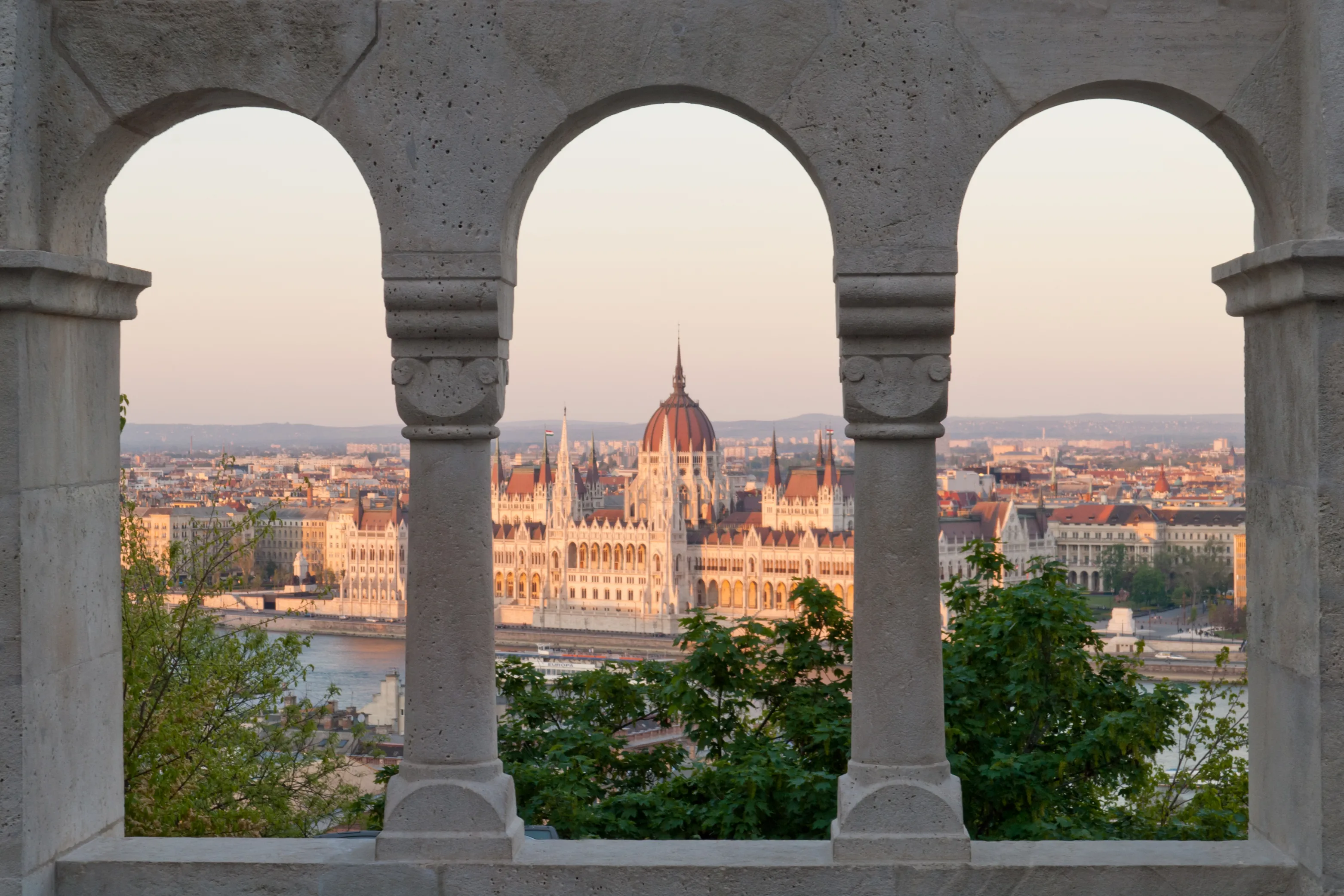
Budapest
Situated at the heart of Europe, Budapest is the capital of Hungary, appropriately named 'The Pearl of the Danube,' for its fixating and almost haunting beauty. Formerly two separate cities, Buda and Pest were forged into one by time, occupation, and the eight bridges that anchor them together today. From the Romans to the Communists, each occupier left its flavor profile in Budapest, evident in the famous spicy Hungarian stew known as 'goulash.' Budapest is a melting pot of history, culture, and taste, from the magnificent Baroque and neo-Gothic architecture to the Turkish thermal baths. After a long day of sightseeing, treat yourself to a glass of Tokaj, what King Louis XIV of France referred to as the "Wine of Kings, King of Wines". Budapest has a flavor to satisfy any taste.
Read More
Learn About Budapest
Build Budapest Trip

Cesky Krumlov
Cesky Krumlov is a charming little town in South Bohemia. It might be small, but it’s full of whimsical character and mystery. Walking through the narrow streets and across the bridge, the views of the medieval Cesky Krumlov Castle will take your breath away. At night, street musicians serenade visitors on the bridge where you can dance beneath the stars and the watchful eye of the magnificent tower. Dozens of unique local artisan shops, cafes, and restaurants are woven among the winding streets. In the summer, the city is lush with life and greenery. Rafters race down the river, stopping in the center along the way to enjoy a hearty meal before continuing their journey. In the winter, the main square transforms into a magnificent Christmas market and light blankets of snow cover the rooftops. This quaint little town will exceed your expectations and you may never want to leave.
Read More
Learn About Cesky Krumlov
Build Cesky Krumlov Trip

Dresden
Nearly every wall and rooftop in Dresden seems to be finished with a flourish. Defined by its ornamental baroque architecture, a power statement of Saxon royalty, Dresden is made all the more miraculous considering the city was leveled by firebombing in WWII. After the war, the city was reconstructed, brick by painstaking brick. Even under East German-Soviet rule, which usually eschewed frivolous design, buildings like the Semper Opera House were pieced back to their former glory. Restoration of the majestic Zwinger Palace and bell domed Church of Our Lady slowly followed, with the Frauenkirche only fully repaired in 2005. Arguably there is no other city in Europe that cherishes its hard-won architecture as much as Dresden. Although it is a compact city, so many of its buildings will stop you in your tracks that architecture fans will easily lose a whole day in the Old Town area. Especially during the winter months, Dresden sparkles with a joyous, uplifting ambiance. The city is recognized as having the best-ever Christmas market in all of Europe. Between the twinkling lights, the scent of hot wine and gingerbread, and the towering Christmas tree, it’s worth going out of your way to see Dresden at this time of year.
Read More
Learn About Dresden
Build Dresden Trip

Nuremberg
One of the most authentic, storied German destinations, Nuremberg's picturesque old town, glorious castle, and buzzing Christmas Market makes this city a time-true classic. The ideal gateway to old Bavaria, Nuremberg offers a primer in German history before you embark on the lovely journey through old Bavaria, known as the Romantic Road. Considered the capital of the Holy Roman Empire in the middle ages, Nuremberg would have felt like the center of the world as a procession of kings and emperors passed through its magnificent gates. When the German Renaissance came, Nuremberg was at its heart. Albrecht Dürer, the great German master artist, was born here, and Martin Luther called Nuremberg Germany's 'eyes and ears'. Skip forward a few centuries, and the city took a dark turn, as Nuremberg became a gathering point for the German National Socialists. Slightly outside of town, you can still find the Nazi Party Rallying Grounds, a sobering reminder of the not so distant past. If it all gets too heavy, you can end the day with a glass of rotbier (red beer) and mull it over. Nuremberg is a must-see for anyone who wants to delve into Germany's past.
Read More
Learn About Nuremberg
Build Nuremberg Trip

Prague
The city of Prague is indisputably the gem of Central Europe. Full of history, culture, and classic Czech pubs around every corner, Prague is teeming with nooks and crannies just waiting to be discovered. The narrow cobblestone streets and warm red rooftops give the city a homey feel, while the well-preserved medieval architecture transports you back in time. Walking across the Charles Bridge with the view of the Prague Castle will make you feel like you’re living in a fairytale, and you might as well be. As an up-and-coming destination, Prague is a perfect mix of classic and modern. New trendy cafes and bistros are always popping up, and you can always find a group of lively locals chowing down on goulash and quaffing pivo (the best beer in Europe!) at traditional Czech restaurants across the city. The clash of modernity and tradition, preservation and innovation, gives this city a mysterious air that you won’t soon forget.
Read More
Learn About Prague
Build Prague Trip

Vienna
Artistic and musical, historical and elegant, Vienna is the definition of class. The seat of the Habsburg monarchy for over six centuries, it's no wonder this city is still fit for royalty. Baroque buildings and imperial palaces dominate the cityscape, while locals stride gracefully through the streets, likely on their way to a classical music concert or art exhibition. Visitors from all over the world flock to Schonbrunn Palace, historical museums, and local eateries for authentic Viennese schnitzel. Vienna is also home to world-class wining and dining. Famous dishes include Wiener schnitzel, Tafelspitz (prime boiled beef), and apfelstrudel (apple strudel), all of which pair well with a glass of fine Austrian wine. No matter how long you spend in Vienna, you'll leave with a new appreciation for the finer things in life.
Read More
Learn About Vienna
Build Vienna Trip

Budapest
Situated at the heart of Europe, Budapest is the capital of Hungary, appropriately named 'The Pearl of the Danube,' for its fixating and almost haunting beauty. Formerly two separate cities, Buda and Pest were forged into one by time, occupation, and the eight bridges that anchor them together today. From the Romans to the Communists, each occupier left its flavor profile in Budapest, evident in the famous spicy Hungarian stew known as 'goulash.' Budapest is a melting pot of history, culture, and taste, from the magnificent Baroque and neo-Gothic architecture to the Turkish thermal baths. After a long day of sightseeing, treat yourself to a glass of Tokaj, what King Louis XIV of France referred to as the "Wine of Kings, King of Wines". Budapest has a flavor to satisfy any taste.
Read More
Learn About Budapest
Build Budapest Trip
prev
next


 Map of Your Itinerary Route
Map of Your Itinerary Route
Zoom In to the cities to see your itinerary in more detail


 4.8
4.8 







